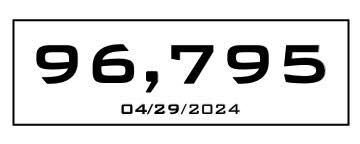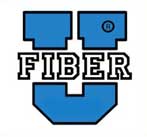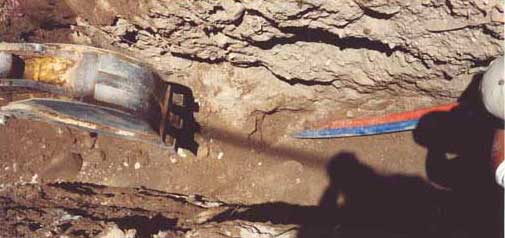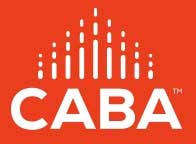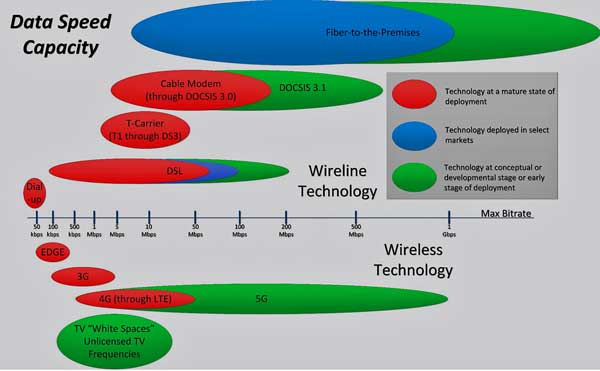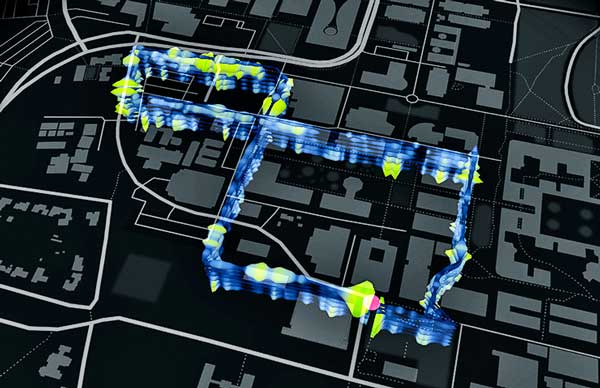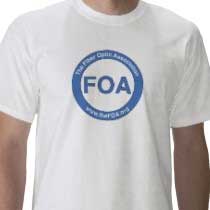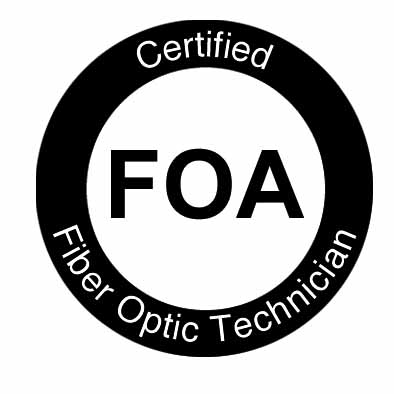Can Underground Fiber Optic Cables Monitor For Earthquakes?
Currently, researchers monitor earthquakes with seismometers, which are more sensitive than the proposed telecom array, but their coverage is sparse and they can be challenging and expensive to install and maintain, especially in urban areas.
By contrast, a seismic observatory like the one Biondi proposes would be relatively inexpensive to operate. “Every meter of optical fiber in our network acts like a sensor and costs less than a dollar to install,” Biondi says. “You will never be able to create a network using conventional seismometers with that kind of coverage, density, and price.”
But since the fiber optic seismic observatory began operation in September 2016, it has recorded and cataloged more than 800 events, ranging from manmade events and small, barely felt local temblors to powerful, deadly catastrophes like the recent earthquakes that struck more than 2,000 miles away in Mexico. In one particularly revealing experiment, the underground array picked up signals from two small local earthquakes with magnitudes of 1.6 and 1.8.
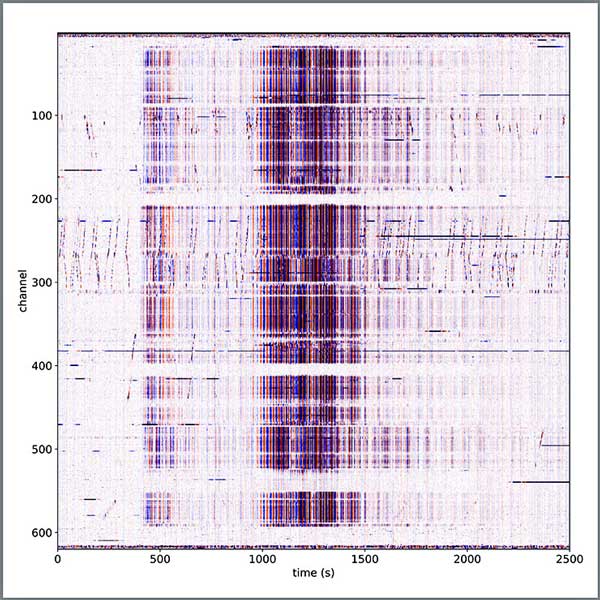
The fiber optic seismic observatory successfully detected the 8.2 magnitude earthquake that struck central Mexico on Sept. 8, 2017. (Credit: Siyuan Yuan/Stanford)
The fiber optic seismic observatory is just the first step toward developing a Bay Area-wide seismic network, Biondi says, and there are still many hurdles to overcome, such as demonstrating that the array can operate on a city-wide scale.
The researchers will describe their findings in the journal The Leading Edge in December. A paper focused on their signal processing methods will appear in the January edition of IEEE Signal Processing Magazine.
You can read the preliminary announcement here in the Futurity Newsletter. (FYI - if you like to follow technical and scientific developments, the Futurity Newsletter is published by a consortium of universities to cover all topics of university research. It's simply great.)
FOA Members And Instructors Working To Repair Hurricane Damage in Houston, Florida and Puerto Rico
Last month we showed photos from Houston, Texas showing the damage caused by the recent hurricane. Of course that was followed by another hurricane that destroyed part of the infrastructure in Florida and Puerto Rico. We heard from some of our FOA contacts that damage to the power grid control systems was massive and we were told that in one case fiber cable was laid along the ground to replace cable lost when towers were damaged, waiting for the towers to be repaired. Our instructors have been working to train new personnel needed for the massive amount of repair work.
FOA instructor Jorge Aponte sent us some photos of the damage in Puerto Rico, the area most damaged by the Hurricane Maria.

Damage to utility poles

Even underground cable plant is not 100% safe in a major storm
 
The survival rate for cell towers in the hurricane was extremely low - the green indicates towers that survived.
If you are interested in helping in TX. FL or PR, check online job sites, local utilities or contact the FOA at info@foa.org.
Is This The End Of “Real” Fiber Optic Standards In The US?
We just returned from a TIA standards meeting, which as usual had a few surprises. During the meeting, we realized we may be nearing the end of “real” fiber optic standards in the US. It was predictable. In fact I predicted it in 2009 when TIA announced that they were merging the old FO-4 fiber optic standards committee into the TR-42 structured cabling committee.
The merger occurred because the FO committees which had been meeting for over 25 years were losing steam. Most of the important topics had been covered - component specifications had been standardized and about 200 testing FOTPs (fiber optic test procedures) had been written. Attendance was down, only 3 active committees were left and no one asked (including yours truly) was willing to assume the chairmanship. Since the FO committees had been meeting at the same time and location with the TR-42 committees and TR-42 had ongoing work adding fiber to the structured cabling standards, making fiber part of the TR-42 group seemed to make sense. Or did it?
When I heard the news, I sent emails to several members of both committees expressing my concern. One of my sarcastic comments was “Who decided a fiber optic technology group that covers anything related to communications fiber optics gets stuffed into a premises cabling group run by copperheads?” (JH email, June 3, 2009)
I'm now saying "I told you so." Almost a decade later, at the meeting in Las Vegas last month, I made the comment in one of the subcommittee meetings that the document we were discussing was an example of how TR-42 had recast fiber optic standards into structured cabling standards, abandoning the general fiber optic market.
The first really important example of this was the adulteration of OFSTP-14, the test standard for installed multimode cable plants that I helped write in the late 1980s. The new version of OFSTP-14 was adopted from an ISO document that was created as a vehicle to require “encircled flux” mode conditioning in the multimode standards. Rather than being about how to test the cable plant, the majority of the new standard was about encircled flux. You had to go all the way to the back to Annex A to learn how to actually test a cable plant.
The updates of OFSTP-14 and more recently FOTP-171, many of the fiber optic standards have been rewritten to support the latest version of TIA-568. The older fibers that are still in wide use like 62.5/125 (now called OM1) and the early 50/125 (OM2) are not now recognized in these standards, confusing to many users who still have these older fibers in use. We know because they call FOA asking us questions. We tell them their systems are no longer recognized by the current standards and they need to refer to earlier versions that applied to them.
Within the US, I’d guess less than 5% of all fiber applications are in structured cabling, probably only 50% of multimode. In the committees, the majority of the attendees are from companies specializing in structured cabling. So what’s happening is not surprising.
I’m still amazed by some of the stuff I see, especially coming out of international committees. For example at the Las Vegas meeting, an IEC document (IEC TR 61282-15) was presented to the group purporting to cover testing multifiber MPO connectors. Look at how this document defined a connector:
“connector - component consisting of two plugs mated together in an adapter, for the purpose of providing frequent optical interconnection/disconnection of optical fibres or cables, between two cables, or a cable to an apparatus”
The rest of the world would call this a “connection” as the committee agreed when I pointed it out. Perhaps it was "lost in translation," but can anyone tell me how " two plugs mated together in an adapter" connects to "an apparatus" like a pluggable transceiver?
And then there is this definition:
“light source power meter - test system consisting of a light source (LS), power meter (PM) and associated test cords used to measure the attenuation of installed cable plant”
That’s also crazy - reference test cords (the ISO standards uses the term cords instead of cables) are not considered part of the test equipment.
There was more - the document used “back reflection” (an obsolete, incorrect term), reflectance and return loss interchangeably (often in the same paragraph) without defining any of the three terms. And what it purported to cover, testing MPOs, was incomplete and confusing. You are better off going to the FOA Guide page on MPOs: http://www.thefoa.org/tech/ref/testing/test/test-MPO.html which explains the issues in understandable language.
We know these standards are written by manufacturers for manufacturers - we've been told that many times by TR-42 people. What's a user/designer/contractor/installer to do? FOA responded to this a few years ago, creating what we called 1-page standards, simple explanations of the test methods with clear drawings. Can a single page explain what is covered in a 30-40 page standard. Yes it can - check them out. FOA Standards.
JH
Fiber Optics Used In Aerostat Tethers
Linden Photonics has been known for its cables used in underwater ROVs (remote operated vehicles) and we ran an article about one of their cables used in Antarctica with a probe through a hole in the ice. Now they have added a new application to their protfolio, tethered balloons called Aerostats used for surveillance and communications.
Linden is now leveraging its experience as a subsea cable supplier and experience with light-weight, high strength materials to service the airborne industry. These hybrid cables have wires for power & fiber for data and are designed to be durable for repeated use yet as light weight as possible for maximum payload capacity.
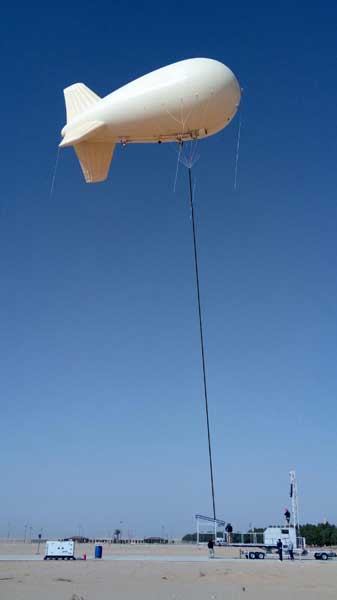 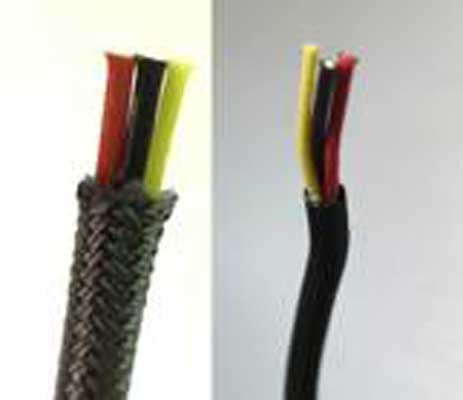 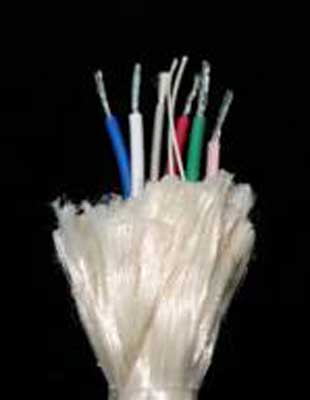
Airborne Industries aerostat and Linden Photonics rugged, extra strength cables used for tethers. Note the large amount of strength members in the cable.
Fun reading!
Is It April Fool's Already? Or Is It " Fake News"?
We read this in an email newsletter we get from CI&M magazine. You can read the article here.

Consider this:
1) Can PoE provide the power? The lowest power normal PCs use 30-100W power and a 21" LCD display uses about 90W for 120-190W total. A 21" iMac with the low res LCD uses about 75W but the retina display versions uses 161W. Can these people convince PC manufacturers to build such computers? Will companies buy then instead of laptops?
2) Practically all workers today use laptops not desktop computers. Typical users of desktops are power users doing engineering or graphics on workstations that require really high power. This idea could work for lapstops that use lower power, I suppose because most are within the 90W limit. But most modern laptops do not have a jack for Cat 5 - none of ours do!
3) Practically all of those laptops people use are connecting to the network using WiFi or maybe cellular wireless.
4) Because of building codes, wherever a worker sits will have AC outlets.
Perhaps just another sign that the "Cat 5"community is really grasping for something to do with all that copper wire in warehouses! Just like the plan to run LED lighting off all those too small conductors. All these proposals have also brought PoE to the attention of the people writing electrical codes because the high power heats up the cables sufficiently to be a potential hazard.
Read the article for yourself here.
Production Capacity Expands at OFS to Meet Global Demand

OFS owner Furukawa Electric plans to nearly double its 2016 optical fiber manufacturing capacity by 2019 and to increase its optical fiber cable manufacturing capacity as well, thereby creating over 400 jobs over the next two years. Between 2014 and 2016, Furukawa Electric increased its global fiber production capacity by 20% and planned to achieve another capacity increase of 20% by 2018.
“The proliferation of hyper-scale and edge data centers, 5G wireless, and fiber-to-the-home (FTTH), along with the greater digitization of communications in business, are creating the need for fiber in the network around the world,” said Timothy F. Murray, CEO of OFS. “Furukawa Electric is responding with greater capacity as we foresee this demand continuing into the next decade with communication traffic estimated to increase during this period. Furukawa Electric will continue to serve its global customer base and to contribute to growing communication solutions in the market through a company-wide effort.”
Read more.
The OFS Blog has lots of interesting stories - check out the one on "rollable ribbon."
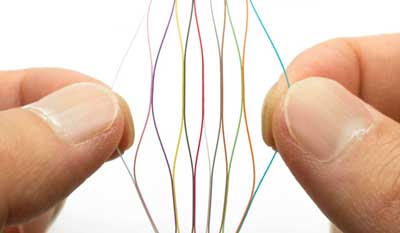
Want To Rent Dark Fiber? Nokia Will Sell You The Electronics To Build Your Network
Nokia has unveiled a line of optical transport platforms designed to meet the needs of enterprises who want their own fiber-optic networks. The portfolio aims to provide simple, low-cost transport when paired with dark fiber.
According to Kyle Hollasch, director of product marketing, optical networking, at Nokia, the growing interest in cloud services and edge computing, as well as greater availability of dark fiber, has piqued the interest of hospitals, banks, and other large enterprises in managing their own optical connectivity. Neither typical metro systems nor the new wave of data center interconnect platforms quite meet such needs adequately, Hollasch said, and therefore a new set of platforms makes sense.
In addition to enterprises, Hollasch says Nokia expects to generate interest in the WaveLite platforms among service providers who want to offer private networks as a managed service. In fact, initial WaveLite customers include a communications services provider in Europe as well as a cable operator and a Chinese internet content provider. He added the company also is shipping systems to enterprises.
Read the story in Lightwave
EasySplicer Introduces Upgrades: LC SOCs - Splice-On Connectors
The manufacturers of the EasySplicer have been supporting many of the FOA schools with their fusion splicer. Our schools like them because they are simple, easy to use rugged and reliable, important for being used in the classroom or the field. The company has just introduced an upgrade with some new features and improvements including the availability of LC SOCs which is important for data centers and high speed networks. Upgrades include long life electrodes (5000 fuses) and a higher temperature oven that can shrink SOC sleeves better. A upgraded cleaver now includes a fiber trash bin to keep fiber shards off the workbench. And software updates provide better functionality.
Note all the new hardware is compatible with all EasySplicers in the field now so you can easily upgrade.
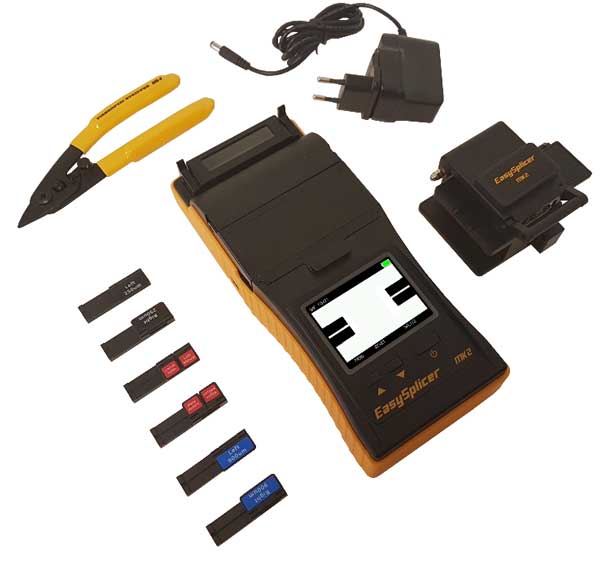
For more information go here (worldwide) or here (US) or contact the manufacturer for your local EasySplicer distributor.
Two New Publications Available From FOA
Have You Downloaded Your Copy Of The Updated
ANSI/NECA/FOA Fiber Optic Installation Standard Yet?
Available Free Courtesy of FOA
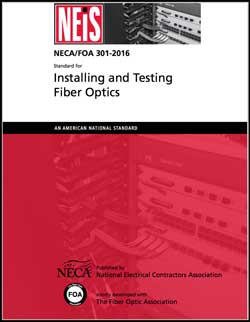
NECA/FOA-301was created to be a document that could be used as a guide to installation practices and also be quoted in project paperwork to define what was meant by installation in a "neat and workmanlike manner." This standard was the first standard to approach the issues of installation of fiber optics in a document that could be used by network owners, project managers, contractors, installers, test techs, maintenance personnel and even the manufacturers making the products being installed following this standard.
Go here for more information on NECA/FOA-301 and directions for a free download.
FOA's Latest Textbook - Fiber Optic Testing
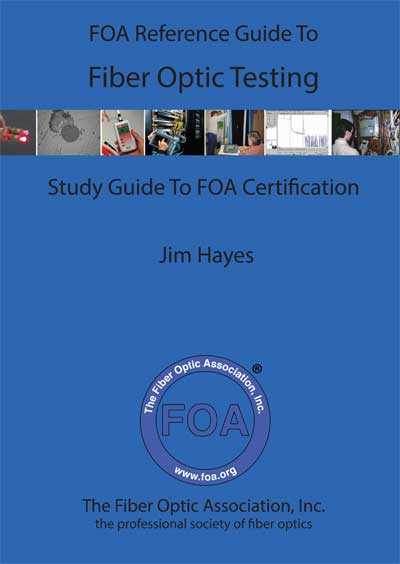
FOA Reference Guide To Fiber Optic Testing
OTDR Talk
Many of the FOA inquiries are about testing and most of those are about OTDRs. Several interesting questions were asked this month.
The first one deals with this event table:
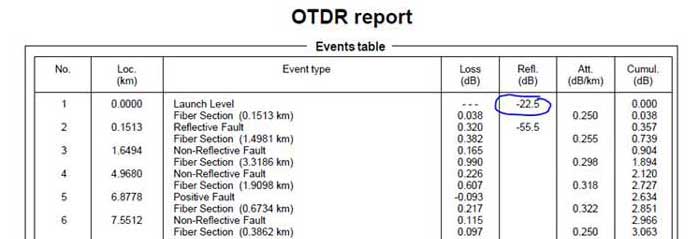
This was sent to us by a tech testing cables at a job site with an OTDR. The OTDR launch cable was ~150m. The cable being tested had a number of fusion splices which you can see were not reflective. The customer's spec for reflectance was -40dB, so all the fusion splices passed. But the cable was rejected because of the first event - that was the connection of the launch cable to the OTDR.
The tech called us to help him explain to the customer that the reflective joint at the OTDR had nothing to do with his cable. We helped on that. But it brought up an interesting topic - why did the OTDR manufacturer include that data anyway? If you are using a launch cable, it has nothing to do with the cable under test and is mostly just a confusion factor. So we contacted the manufacturer. Their explanation was it showed the condition of the connection at the OTDR and when you see a high reflectance like this you can assume it affects the dead zone of the OTDR. It also tells you to inspect and clean this connection. We can see that, but it is very confusing to someone who is not very familiar with OTDR data. We could see it as a self-test mode, but not in every data table. What do you think?
Note: Several recent OTDRs we have tested have had SC-APC connectors that greatly reduce the reflectance at the instrument interface. We also recommend using a short cable to connect the launch cable to the OTDR that stays on the OTDR all the time. Not making that connection protects the OTDR interface connector from excessive weer that affects both loss and reflectance.
The second one deals with OTDR setup:
We got this question in an email: What are good OTDR settings for a 300-500m fibers? We’re using a 1.5 m launch cable and sometimes got (-) loss.
Our answer was that a 1.5m cable is not a launch cable. A launch cable must be long enough to allow the OTDR to settle down after the test pulse. THe negative loss is because the OTDR has not settled down sufficiently. Generally the minimum launch cable for testing short cables would be 10-20m for MM, 100m for SM. Then use the shortest test pulse, ~1km range, average enough to reduce the noise.
Number 3 deals with distance:
We received a question about a VFL that would help identify longer fibers, up to 10km long, and identify faults in the cable. Our response was you need an OTDR. The high attenuation of the fiber at visible light wavelengths (~650nm) makes it impossible to use VFLs over 2-3km. Then we had to explain what an OTDR was.
And Number 4 deals with OTDR resolution and errors:
Finally, FOA Master Instructor Eric Pearson was doing some comparison tests with several OTDRs for a new chapter in one of his books. He made an interesting observation - the variation in attenuation coefficient of fiber tested by an OTDR was quite high on short fibers. His experiments showed the variation was generally also sensitive to pulse width.
Think about how OTDRs measure attenuation:
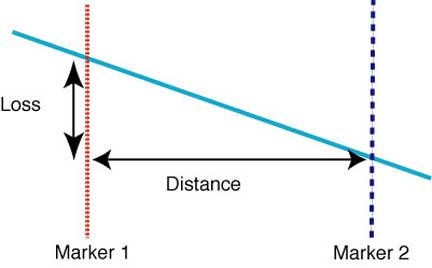
If you are measuring a short length of fiber, say 100m, with MM fiber, the loss is going to be ~0.3 dB, with SM ~0.04dB. Depending on the OTDR range settings, the resolution of the OTDR can become significantly large compared to the values measured, causing digitiztion errors. Added to this, any nonlinearity in the fiber trace caused for example by recovery from the dead zone after a reflective connection - dependent on pulse width - can have a very large effect on the error of the measurement.
Think about it this way:
The variability on short length measurements can be explained by statistics.
Attenuation coefficient = Loss / length
The uncertainty of the measurement is a combination of the errors in each measurement
Attenuation coefficient = Loss+/-error <divided by> length+/-error
Errors have both fixed components-same for all measurements - and variable components-functions of the value being measured
For small values, fixed components tend to be more important as they will become a larger percentage of the measured value
Dividing the two factors compounds the errors statistically
In fact, this is similar to measuring length with a ruler calibrated in mm - you can only read to +/-1mm but that resolution is more important when measuring 10mm than when measuring 100mm!
Using The FOA OTDR Simulator On Windows 10 or A Mac
If you want to learn how an OTDR works or how to interpret traces, you would ideally have an OTDR and lots of cable plants to test. That's impractical for most users, but not for the FOA community. We have collected tons of SOR (the industry standard for OTDRs) files of OTDR traces and used them with a PC program for a OTDR to create an OTDR simulator. You can open and compare traces of one cable plant that show how the different choices in setup (wavelength, range, pulse width, averaging, etc.) affect the traces to understand how to make choices that optimize the trace. Then you can open many traces from networks - very short to very long - including traces through PON splitters and some really graphic gainers!
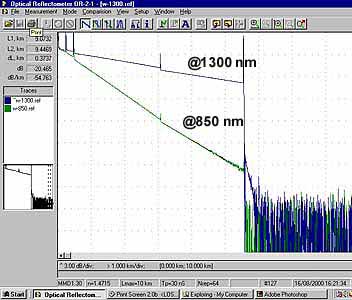
The software has been set up long ago for Windows XP - we know some of you still use it - and Windows 7 - same here - but one of our instructors figured how to use a feature of Windows 10 to make it useful on the latest versions of Windows. FOA thanks Tim Fiegenbaum, Electronics Faculty & Coordinator, North Seattle College for figuring this out and sharing it with the FOA community.
Directions For Using FOA OTDR Simulator On Windows 10
At the following link download the file: “Download the PC Simulator” (Near the bottom of the page). http://www.thefoa.org/tech/ref/testing/OTDR/OTDRsimulator.html
Open the folder: “OTDR Win 7” …unzip
If using Windows 7 or XP, simply install the file: “Setup_uOTDR_V9x.exe”
If using Windows 10
Right click on the file: Setup_uOTDR_V9x.exe and select "Properties"
Select the "Compatibility" tab and select the option for "Windows 7."
Click apply and then OK
Click on the file "Setup_uOTDR_V9x.exe” and follow the direction to install
Open the file "uOTDR.exe" to run the program
The program will run just fine in Windows 10 if the Windows 7 compatibility mode is selected.
Some anti-virus software including Norton 360 will identity Setup_uOTDR_V9x.exe an unsafe and will quarantine the file. If that happens you will need to un-quarantine the file in order to install.
Thanks Tim!
Directions For Using FOA OTDR Simulator On A Mac
Running the OTDR Sim on a Mac is easy. There are several Windows emulators available for the Mac including Apple's own BootCamp, Parallels Desktop, Crossover, WinOnX, Virtual PC and VMware Fusion. We run our OTDR Sim on a Macbook Air using Parallels Desktop.
ANSI/NECA/FOA Fiber Optic Installation Standard
Available Free Courtesy of FOA

The ANSI/NECA/FOA-301-2016 standard for Installing and Testing Fiber Optics has been updated and is available for download from the FOA website. This standard is one of the many volumes in the NECA (National Electrical Contractors Association) NEIS series (National Electrical Installation Standards). FOA and NECA created this standard in 2001 and this is the 3rd revision.
NECA/FOA-301was created to be a document that could be used as a guide to installation practices and also be quoted in project paperwork to define what was meant by installation in a "neat and workmanlike manner." This standard was the first standard to approach the issues of installation of fiber optics in a document that could be used by network owners, project managers, contractors, installers, test techs, maintenance personnel and even the manufacturers making the products being installed following this standard.
Download Free From FOA
As the authors of NECA/FOA-301, FOA feels strongly that this is a standard that every fiber optic tech - designer, installer, tester - as well as network owners should have for reference. Therefore, FOA sponsors distribution of this standard free to those involved in fiber optic projects. We encourage you to download a free PDF copy and tell others to do so themselves.
Go here for more information on NECA/FOA-301 and directions for a free download.
Libro de Diseño para Redes de Fibra Óptica en Español - FOA Design Book Available In Spanish - Online
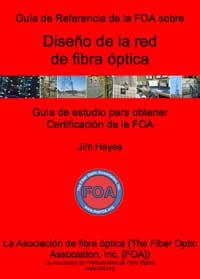
FOA has translated the FOA Guide To Fiber Optic Network Design book and made it available online to those studying for the CFOS/D Certification but whose native language is Spanish. You can access the Spanish translation of the Design book here. A printed version will be available in the near future.
FOA's Newest Textbook - Fiber Optic Testing

FOA has published another "reference guide" textbook: FOA Reference Guide To Fiber Optic Testing. This is a new textbook for training or studying for FOA CFOS/T certifications, and an up-to-date reference on fiber optic testing for the contractor, installer, designer and user.
Fiber optic manufacturers and network users say that testing is the most important aspect of installation and operation of fiber optic networks but often the least well understood. Of all the technical help requests received by the FOA, 90% are about testing. This book has been written by the FOA to provide a comprehensive but understandable technical guide to this important topic.
The FOA Reference Guide To Fiber Optic Testing is a unique book. It covers the topic of fiber optic testing more thoroughly than this topic has ever been covered in a textbook before and in some different ways. Every subject (see Table of Contents below) starts with basic information on why a test is necessary and what test equipment is required which everyone needs to know. Then the chapter expands on how the tests are performed and completes the topic by discussing the potential measurement uncertainty and how to minimize that uncertainty.
Several chapters are at the expert level. Chapter 10 on fiber characterization is technically complex but a subject that is becoming more important for upgrades to older cable plants and new installations intended for 100G and beyond. Chapter 14 on Metrology - the science of measurements - is the longest and most difficult chapter to master. This chapter is aimed at the experienced tech who wants to understand the depths of fiber optic testing and use that information to make their testing more accurate and usually much faster.
List Price: $29.95 ($9.95 on Kindle)
7" x 10" (17.78 x 25.4 cm)
328 pages
ISBN-13: 978-1544289656, ISBN-10: 1544289650
FOA Reference Guide To Fiber Optic Testing
FOA YouTube Videos Now "Closed Captioned"
FOA's YouTube videos are very popular as you can see from the statistics above. We have had requests from teachers and viewers for closed-captioning. Now FOA is upgrading all its YouTube Videos to offer "closed captioning" for those with hearing disabilities - or if you want to view the video quietly and don't have headphones. FOA used a highly-regarded service that does closed-captioning for many of the television networks to ensure accurate captioning.
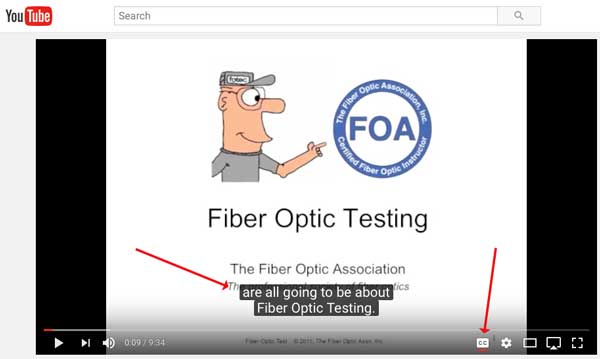
The closed captioning can be turned on by the small "CC" button on the lower right side of the video (right arrow). The captioning shows up on screen in white letters on a black background (left arrow). You can view this video on fiber optic testing here, and try the "CC" button to see how it works.
We hope our viewers find this helpful.
FOA has over 100 YouTube videos on fiber optics, premises cabling and the fiber optic job marketplace. Here is a list with links to them online.
New Website Keeps You Up To Date On Structured Cabling
Liz Goldsmith, manager of the TIA Fiber Optic Technology Consortium (FOTC) has started a new website that aims to keep readers up to data on the news and products in the structured cabling (premises cabling) space. Called Structured Cabling News, it offers news about the industry in more than a dozen categories so you can browse the news by categories (like fiber) that interest you most. Liz sums up the aim of SCN as "SCN brings you current Structured Cabling News curated by category and topic. We search the 'Net so you don't have to - updated daily with industry trends, new products and best practice from industry leaders."
And you can subscribe to daily or weekly digests to keep yourself informed.
Structured Cabling News
Interested In A Career In Fiber Optics?
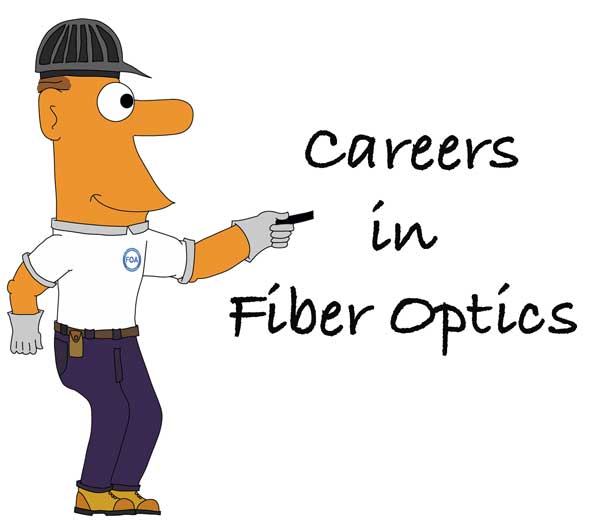
FOA has created a new YouTube video to introduce students to careers in fiber optics. It was made for showing to high school and junior high students interested in tech careers but anyone interested in a possible career in this field will find it interesting. If you have kids in school or know teachers, let them know about this too. Watch the FOA Careers In Fiber Optics Video on YouTube and visit the FOA Careers In Fiber Optics web page at www.foa.org/careers/.
Ed Forrest - NEW Lecture On Cleaning And Inspecting Connectors
Ed Forrest, the person we consider the guru of cleaning fiber optic connectors, has added a video lecture on cleaning. It's a bit long for YouTube, about an hour, but worth every minute of it!
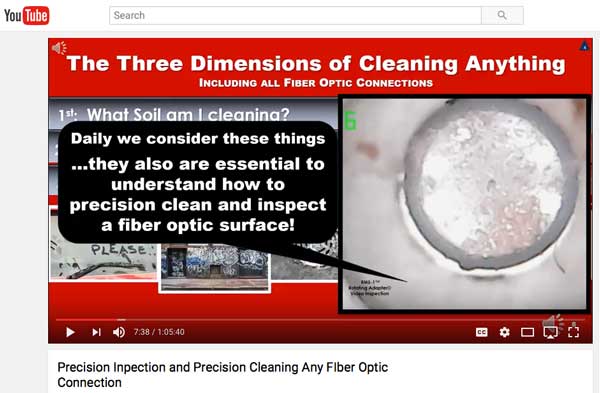
https://www.youtube.com/watch?v=OGIfFQXZmz4
A New Way To View Fiber Optic Connectors
Microscopes are used for inspecting connectors for two primary purposes, checking polished ferrules during termination to ensure proper end finish and checking connectors in the field to determine if they are clean. To date, one type of microscope has been used for both operations, but a new tool from a long time industry expert may change some minds. To inspect polish quality, you need high magnification, typically 100 to 400X, with most users preferring the higher magnification. But if you inspect for dirt at that magnification, you can only see the ferrule end, ignoring the rest of the connector which can be filthy and you will never see it.
Ed Forrest, the "guru of cleaning" has come up with a very useful tool. Ed is well known for his website on cleaning and his books (go to http://fiberopticprecisioncleaning.com/) and has now added a product for inspecting connectors for cleanliness. Instead of a standard microscope, the RMS-1 Fiber Optic Inspector uses a zoom microscope attached to a PC with unique 3D-printed adapters to hold connectors. You get a wide angle view that can show you how clean the connector is really. The biggest advantage is its ability to see the whole MPO connector or into the shell of large multi-fiber connectors like the MIL-38999.
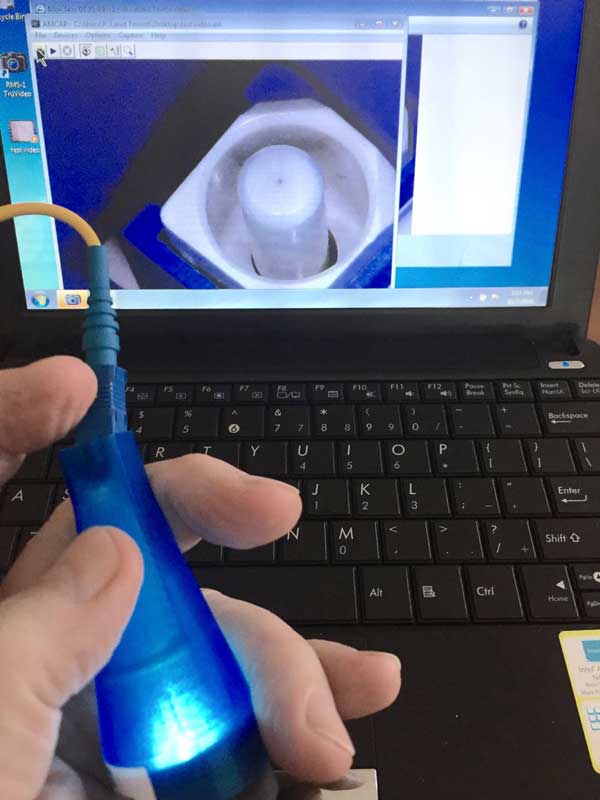
Looking inside a SC connector with the RMS-1
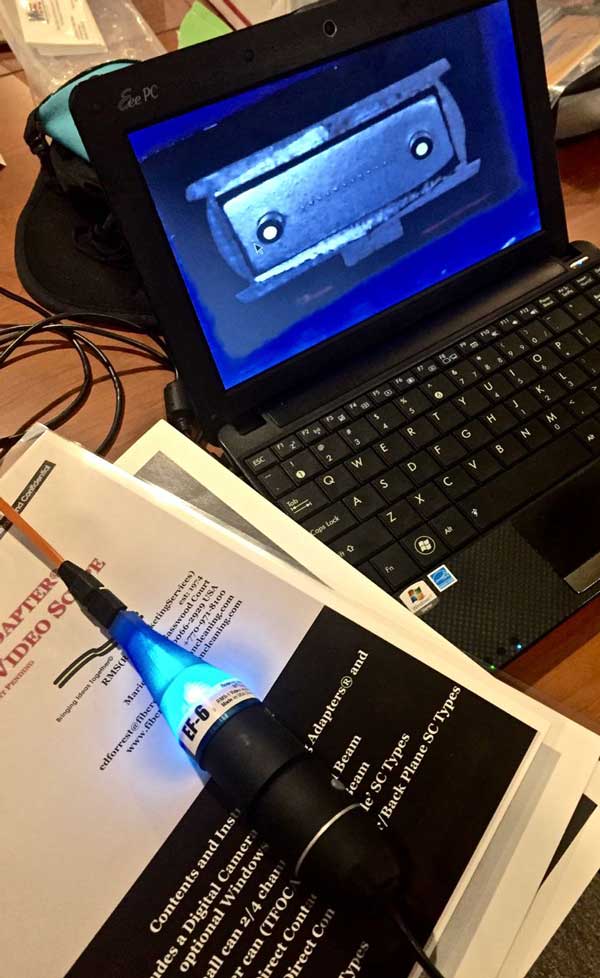
You have probably never seen a MPO connector in this way before
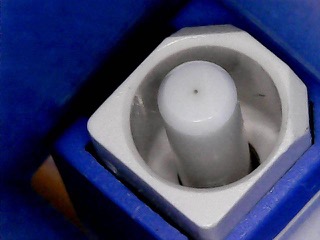 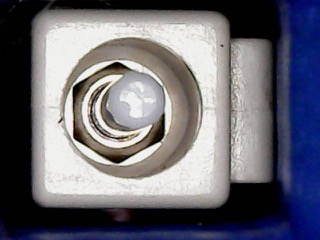 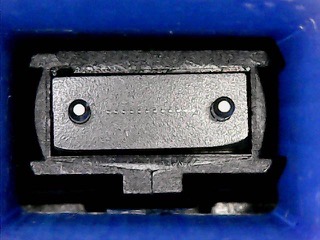
More views of SC, LC and MPO connectors
Here is the datasheet on the RMS-1 Fiber Optic Video Scope
This product is different than other microscopes in many ways. It attaches to a PC or Netbook. The 3D printed adapters take some getting used to, but the results are reallu useful. Ed is still in the development phase, so there is no website yet. Here is his email if you want more information: edwforrest@gmail.com
Locating Underground Utilities - An Overview of Methods
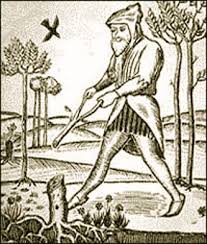
In searching for articles on underground utility location regarding the problems caused by contractors digging up cables and breaking water pipes, we found this interesting summary of methods of location. It includes electromagnetic, acoustic and radar methods, plus one we did not expect - dowsing. Dowsing is a technique for searching for underground water, minerals, or anything invisible, by a person carrying an indicator, traditionally a forked stick, now often paired bent wires, pointing downward toward whatever they are searching for supposedly in response to unseen influences.
We suggest more modern technical methods of searching for buried utilities, but whatever you do, use the resources available before you start digging! Read the FOA Tech Topic. There is a toll-free "call before you dig" number in the USA: 811. See www.call811.com for more information or go to National Fiber Optic Protection Summit by the "811" group. The US Department of Transportation has a website called "National Pipeline Mapping System" that allows one to search for buried pipelines
- But if anyone really has experience with dowsing, tell us about it!
Education and Certification In California
In California, PG&E (Pacific Gas & Electric) has created a program for training and certification for avoiding underground utilities called "Gold Shovel Standard." PG&E developed the Gold Shovel Standard Certification process to ensure that PG&E's hired contractors adhere to the safest excavation standards.
New Viavi Database Illustrates More Than 500 Operational or Planned Deployments Of Gigabit Broadband Globally
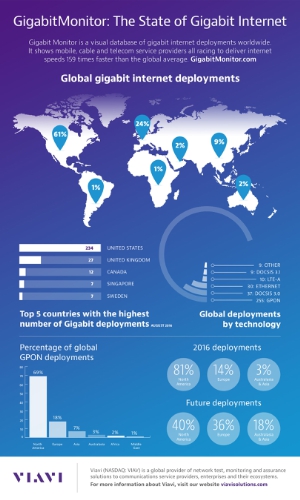
Communications service providers worldwide are accelerating efforts to deliver gigabit internet -- network speed that is 159 times faster than the global average of 6.3 Mbps. The Gigabit Monitor, a visual database referencing current and planned gigabit deployments around the world, from Viavi Solutions (the test equipement company formerly known as JDSU). The Gigabit Monitor paints a picture of mobile, cable and telecom service providers all racing to deliver lightning-fast internet connectivity to meet end users' demands. The database, developed completely from public information, is available at: http://www.gigabitmonitor.com.
Below are some of the key insights from the Gigabit Monitor:
- State of gigabit: There are now at least 350 live gigabit deployments globally, with a further 164 announced or under construction, across wireline and wireless technologies including GPON, DOCSIS 3.1, G.fast, LTE-A, 5G and 802.11ac.
- Contrasts by region: North America has the largest share of announced gigabit deployments, with 61 percent. Europe is second with 24 percent. Asia, Australasia, Middle East, Africa and South America share the remaining 15 percent of deployments.
- Deployments accelerate: The pace of gigabit deployments has accelerated sharply. Over 70 percent of the live gigabit deployments tracked have been launched since the start of 2015.
- Fiber dominates: 85 percent of currently known gigabit deployments are based on optical fiber connectivity. 11 percent are based on Hybrid-fiber coax (HFC), a broadband technology that combines optical fiber and coaxial cable, commonly employed by cable providers.
- Wireless gigabit is already here: Nearly 3 percent of known gigabit deployments are based on LTE-A, a modified version of LTE which is gigabit-capable.
- 5G is coming fast: 37 wireless carriers have announced plans for 5G networks. Five of them plan to have 5G networks built as early as 2017.

The word on the "Dig Once" program is getting out - FOA is getting calls from cities asking us for information and advice. It helps that the current Administration is trying to convince cities of the advantages of installing ducts or conduits when they dig up a street so they don't have to do it again. Here are some links for more information.
The DoT page on the administration’s Executive Order: http://www.fhwa.dot.gov/policy/otps/exeorder.cfm
From the Council of State governments: http://www.csg.org/pubs/capitolideas/enews/cs41_1.aspx
From the city of San Francisco: http://sfgov.org/dt/dig-once
An article about Dakota County, MN: https://muninetworks.org/tags/tags/dig-once
And the one to download and hand out:
A “How To” Guide from The Global Connect Initiative: https://share.america.gov/wp-content/uploads/2016/04/6.-GCI-Dig-Once.pdf
Useful Online Resources
We often have contacts give us online links for useful information which we like to share with our readers. Here are two:
Want To Learn More About DIY FTTH?
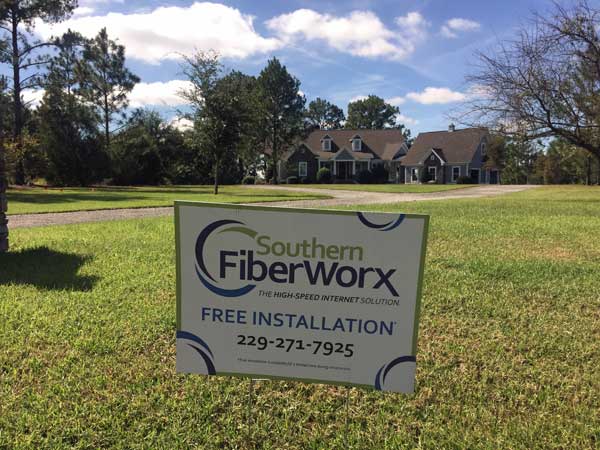 Southern Fiberworx is a DIY FTTH Project in Georgia Southern Fiberworx is a DIY FTTH Project in Georgia
It seems like every week FOA gets another call from a town, real estate developer or utility wanting to start a FTTH project for their area. FOA has created several videos and a a web page on this topic to help anyone get started.
FTTH Case Studies: Do-It-Yourself FTTH
FOA has a series of videos on do it yourself (DIY) FTTH. The first three videos are online now:
FOA Lecture 45 Do It Yourself FTTH (Fiber to the Home) What's involved in building a FTTH network of your own.
FOA Lecture 46 Do It Yourself FTTH (Southern Fiberworx) (FOA Newsletter November 2015) How one company, Southern Fiberworx in Cordele, GA did it themselves.
FOA Lecture 46 Do It Yourself FTTH (Southern Fiberworx) (FOA Newsletter November 2015)
Why We Warn You To Be Careful About Fiber Shards
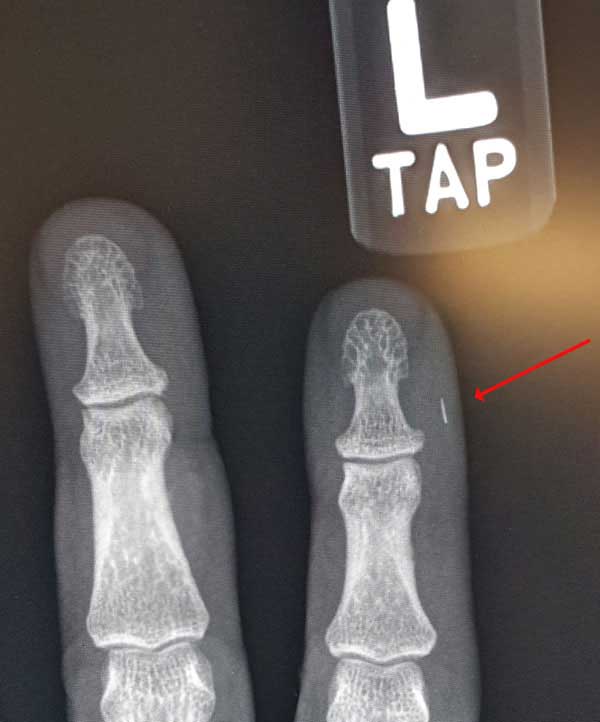
Photo courtesy Brian Brandstetter, Mississauga Training Consultants
1-844-440-0047
www.fiberoptictraining.com
Another Source Of Articles On Fiber
FOA President and editor of this newsletter Jim Hayes has also been writing a column in Electrical Contractor Magazine for more than 15 years now. Electrical contractors do lots of fiber work and this column has covered some toics they are interested in including installation processes, network design, fiber applications and in the last year, a lengthy series on dark fiber - what it is, how's its used and how it benefits the growth of communication. A recent web site redesign makes it easier to browse all these articles - just go to http://www.ecmag.com/contributing-authors/jim-hayes and you can see all of them.
Fiber Optic Education For Students At Any Age
We hear about fiber optics all the time - it's in the news whenever we hear articles about high tech, the Internet and communications, and many communities are getting "fiber to the home." But few people really understand fiber optics or how it works. FOA is focused on educating the workforce that installs and operates these fiber optic networks but we're always getting inquiries from STEM (science, technology, engineering and math) teachers who want to introduce fiber optics to younger students in K-12 grades or technical schools.
We start with the FOA Careers In Fiber Optics Video on YouTube and visit the FOA Careers In Fiber Optics web page at www.foa.org/careers/. These are for students who think they might be interested in careers in fiber optics and want to know more about what fiber techs do.
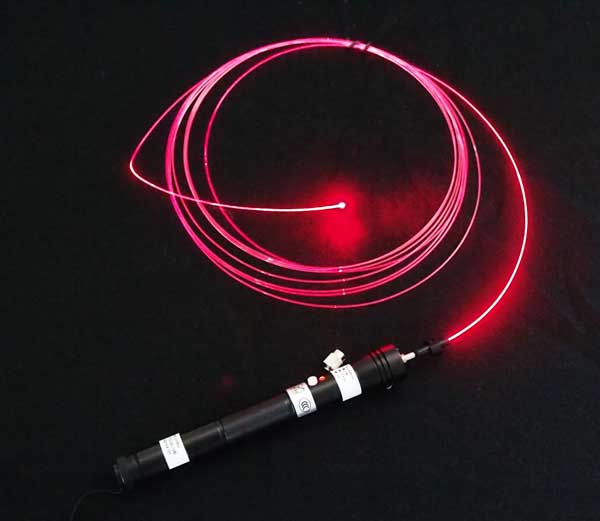
Using red laser light (a VFL here but a laser pointer works also) to show how fiber guides light.
FOA has begun developing a series of YouTube videos intended for teaching students in elementary, middle and high schools about fiber optics. The first FOA video is titled "Fiber Optics For Teachers." With this video, we show teachers how fiber works and carries signals and then explains simple experiments to demonstrate how fiber optics works in the classroom using some plastic fiber and a laser pointer. Since many teachers do not know where to get the fiber, the FOA offers to send them a sample for use in demonstrations in their classroom (USA only right now.)
At the end of the video, teachers are given directions on how to request samples of the plastic fiber from the FOA.
This video joins the "Fiber Optics Live" series How Light Travels In A Fiber, Fiber Attenuation and Connector Loss that show how fiber works using simple experiments that can be duplicated in any classroom. More videos will be coming soon.
If you have kids or know some teachers who would be interested, please send them to the introductory video Fiber Optics For Teachers and we'll be glad to help them get started with some entertaining programs for their classrooms.
Resources For Teachers In K-12 And Technical Schools
Teachers in all grades can introduce their students to fiber optic technology with some simple demonstrations. FOA has created a page for STEM or STEAM (science, technology, engineering, arts and math) teachers with materials appropriate to their classes. Fiber Optic Resources For Teachers.
If you have kids in school or know teachers who are interested, send them to the FOA page Fiber Optic Resources For Teachers.
Should Your Company Become An FOA Corporate Member?
As all FOA individual members know, they join the FOA by becoming certified, mostly taking their CFOTs but some CPCTs, either by attending a FOA approved school or joining directly based on field experience (our "work to cert" program.) Over the years, we've been contacted by manufacturers, contractors, consultants, and other types of organizations who ask about becoming members.
We don't certify companies or organizations, we told them, so we were not sure what we could offer as a benefit of membership. But then, companies asked about using our educational programs to train employees, how they could get listed on the FOA website as service providers or if they could get a quantity discount on membership or certification for all the FOA members working for them. That began to sound like a benefit for being an FOA corporate member. And providing a list of useful suppliers to the market could be a benefit to the industry as a whole.
So FOA has quietly been letting companies and other organizations join the FOA to take advantage of those benefits so we now have several hundred corporate members. We've put then into a database and listed them on the FOA website in map and list form. Here's the map.
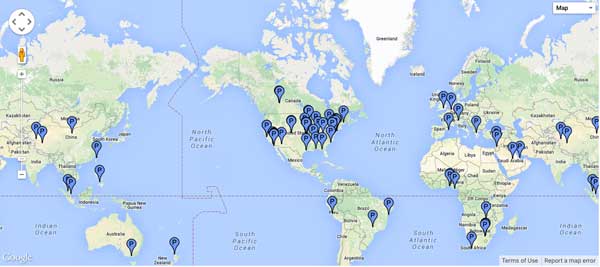
The online map and list can be used to find suppliers and service providers.
The map, like our map of schools, lets you find the FOA corporate members close to you. The table form lists them by category: Installer/Contractor, Component Manufacturer, Installation Equip. Manufacturer, Transmission Equipment, Services/Consulting, Distribution and Users of Fiber Optic Networks. You can sort the tables to find members meeting your needs, e.g. by location, certifications offered, etc. Click on any column heading to sort that column; click twice to sort in reverse order.
How Does An Organization Become An FOA Corporate Member?
Simple, just fill in the online application form. When your application is accepted, you will be asked to pay the membership fee - $100US first year, $50US/year or $100US/3years to renew. You will then be listed on the online map and list, have access to exclusive FOA educational materials for your employees and get discounts on certifications and renewals.
Safety On The Job
 
Safety is the most important part of any job. Installers need to understand the safety issues to be safe. An excellent guide to analyzing job hazards is from OSHA, the US Occupational Safety and Health Administration. Here is a link to their guide for job hazard analysis.
FOA also has lots of information on safety: FOA Guide, YouTube video and a Safety Poster
"Worth Reading" Is Now On
Join FOA on Pinterest. We have been posting links to pages "Worth Reading" on a special FOA Pinterest page. You can join and keep up to date with the news on our industry which we put there.
Recent posts cover utilities using new generation telecom, India's plan for 100 smart cities, Cincinnati Bell bets on fiber, various opinions on the US battle over net neutrality, etc.
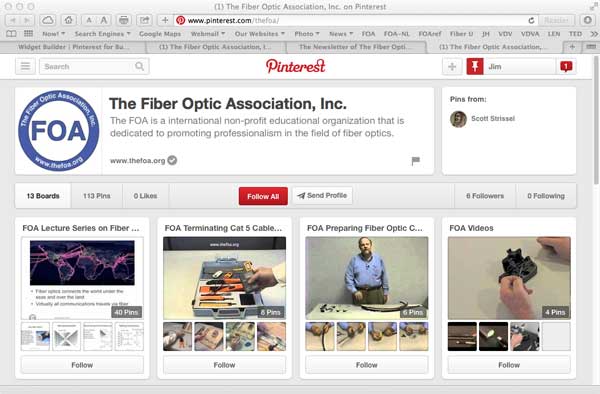
Good Practice Tools For OTDRs, All Free
FOA OTDR Simulator
You may already know that the FOA has a free OTDR Simulator you can download from our website (go here for directions) that allows you to practice using an OTDR on your PC (Win XP or 7), seeing the effects of changing setup parameters and analyzing dozens of real world traces. But here are two more tools that can be good for practice.
OTDR FAQs
Including more hints from FOA Master Instructor Terry O'Malley like tests on what the end of a fiber trace looks like with broken and cleaved fibers.
Frequently Asked Questions On OTDRS And Hints On Their Use
"Fiberizer" APP Reads, Analyzes OTDR Traces
Fiberizer is a iPhone/iPad APP that reads industry-standard ".sor" format files and allows trace analysis on your iPhone or iPad. An android version is in the works too. Read more about Fiberizer. And here are more directions on its use.
Events of Interest
FOA now posts events on our LinkedIn groups, Facebook page and other social media

FOA has a company page and three LinkedIn Groups
FOA - official company page on LinkedIn
FOA - covers FOA, technology and jobs in the fiber optic marketplace
FOA Fiber Optic Training - open to all, covers fiber optic technology and training topics
Grupo de La Asociación de Fibra Óptica FOA (Español)
RETURN TO INDEX
 What's Happening @ FOA What's Happening @ FOA
FOA Standards:
FOA now offers free standards for datalinks and testing the installed fiber optic cable plant, patchcords and cable, optical power from transmitters or at receivers and OTDR testing. Look for the "1 PageStandard" web page and in the FOA Online Reference Guide.
NECA/FOA 301 Fiber Optic Installation Standard
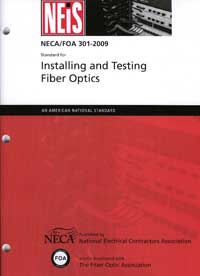
Standards cover components and systems and how to test them, but rarely get into installation issues. The FOA NECA 301 standard which covers installation of optical fiber systems has been revised for the second time, adding considerable new materials. This standard is derived from FOA educational material put in standards form and approved by ANSI as an American National Standard. It's specifically written to be used in contracts to define "installation in a neat and workmanlike manner." The standard is available from NECA. FOA members can go here for instructions on how to download your free copy.
RETURN TO INDEX
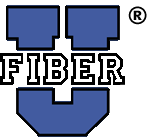
Free Fiber U Self-Study Programs
FOA's "Fiber U" free online self-study programs help you learn about fiber optics, study for FOA certifications or use them to help create "blended learning" classes. There are two new free online self-study programs on Fiber U. Fiber Optic Network Design is for those interested in learning more about how to design fiber optic networks or studying for the CFOS/D certification. FTTx is for those wanting to know more about fiber to the "x" - curb, home, wireless, etc. - or studying for the CFOS/H certification.
Got to Fiber U for more information.
Fiber U Online Self-Study Programs Offer Certificates of Completion
FOA has been offering quite a few free online self-study programs on Fiber U, our online learning site. We are always getting questions about getting a certificate for completing the course online, so we have setup an option to take a test online and get a certificate of completion for these online courses.
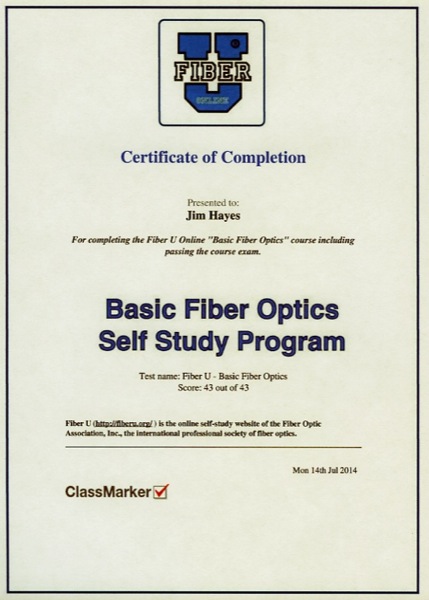
While it's not FOA certification, FOA will recognize a Fiber U Certificate of Completion as background experience to qualify for applying for FOA certifications. We also intend to expand the program to more specialized topics as preparation for FOA specialist certifications.
If you have associates that want to get started in fiber, have them take this course online to get started. Go to Fiber U and get started.
Lennie & Uncle Ted Guides - Perfect For Getting Started
Lennie and Uncle Ted's Guides have moved to the FOA website. Lennie is the place where many if not most fiber techs begin their education. FOA has just updated the two guides to ensure they stay relevant - more than 20 years after they were first written.
Lennie goes all the way back to 1993 when he was created as the mascot of the original "Fiber U" conference - the same Fiber U that is now the FOA's web-based training site. Lennie Lightwave's Guide To Fiber Optics was created as a beginner's introduction to fiber optics. Over 60,000 printed version of Lennie's Guide were given away and it became one of the first commercial web pages in 1994. Uncle Ted's Guide To Communications Cabling was written a few years later to introduce techs to "Cat 5" - UTP wiring - that had only recently been standardized in TIA-568.
Lennie and Ted's Guides are used in the current Fiber U online self-study programs and are still the best place to start learning about fiber optics.
Lennie and Uncle Ted's Guides are online at the links here, can be downloaded as printable PDFs and are now also available as free iBooks on iTunes.
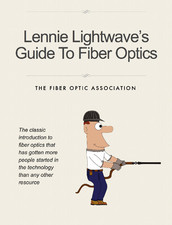 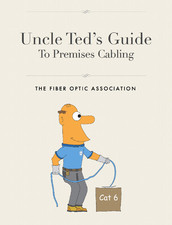
Lennie Lightwave's Guide to Fiber Optics and Uncle Ted's Guide To Communications Cabling are now available free to iPad users who can download them from the Apple iTunes store. Of course they are still available online or for download.
You can also find these free guides on the FOA website - go here for all the links: Lennie Lightwave's Guide to Fiber Optics and Uncle Ted's Guide To Communications Cabling
 FOA Reference Guide To Fiber Optic Testing FOA Reference Guide To Fiber Optic Testing

FOA Basic Fiber Optic Textbook Now Also Available in French and Spanish
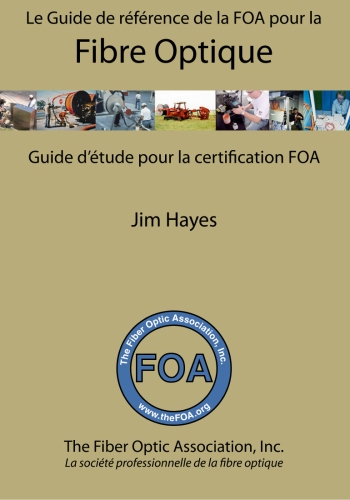 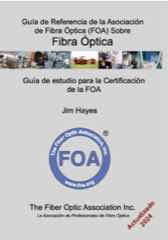   
FOA Reference Guide To Fiber Optic Network Design And FOA's Outside Plant Fiber Optic Construction Guide
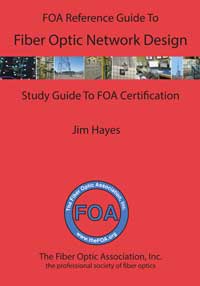 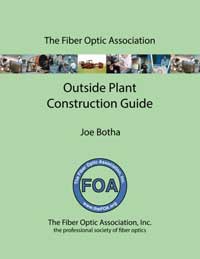
Read More about the FOA Reference Guide To Fiber Optic Network Design and More information on the FOA Outside Plant Fiber Optics Construction Guide
RETURN TO INDEX
FOA iPad Apps
FOA LossCalc
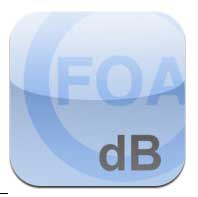 FOA LossCalc estimates the optical loss of a fiber optic link. This will save time for the installer of a fiber optic link needing to know whether test results are reasonable and/or make a "pass/fail" determination. It can also help the designer of a link to determine if communications equipment will operate over this link. FOA LossCalc estimates the optical loss of a fiber optic link. This will save time for the installer of a fiber optic link needing to know whether test results are reasonable and/or make a "pass/fail" determination. It can also help the designer of a link to determine if communications equipment will operate over this link.
By choosing the type of link (singlemode or multimode) and specifying the length of the fiber and numbers of connections and splices, it will calculate the end to end loss of the link. The app has default specifications for singlemode and multimode links or the user may create custom setups with specifications appropriate for any application. http://itunes.apple.com/us/app/foa-losscalc/id476262894?mt=8&ls=1
Self -Study in Fiber Optics
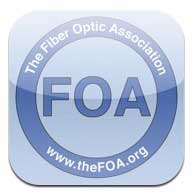 Our first app is a self-study version of the FOA Reference Guide to Fiber Optics. The FOA APP builds on the FOA basic fiber optic textbook to create an interactive learning environment that builds on the iBook electronic version of the book to add a guide to use for self-study and real-time testing that provides feedback on what you have learned and correct answers to questions answered incorrectly. Our first app is a self-study version of the FOA Reference Guide to Fiber Optics. The FOA APP builds on the FOA basic fiber optic textbook to create an interactive learning environment that builds on the iBook electronic version of the book to add a guide to use for self-study and real-time testing that provides feedback on what you have learned and correct answers to questions answered incorrectly.
The FOA APP is priced at only $9.99, same as the iBook, so the self-study program is free. Download it from the Apple APP Store with your iPad or iTunes.
http://itunes.apple.com/us/app/foa-guide/id434354283?mt=8&ign-mpt=uo%3D4
RETURN TO INDEX

The FOA has many videos on  , including two Lecture Series (Fiber Optics and Premises Cabling), Hands-On lectures on both and some other informational and instructional videos. For all the videos, go to the FOA Channel "thefoainc" or use the direct links below. , including two Lecture Series (Fiber Optics and Premises Cabling), Hands-On lectures on both and some other informational and instructional videos. For all the videos, go to the FOA Channel "thefoainc" or use the direct links below.
View a complete list of FOA Videos with links to each video on YouTube.
Where Are The Jobs In Fiber Optics? FOA talks about all the applications for fiber optics, what jobs involve and the qualifications for the workers in the field.
Fiber Optics - Live! A series of videos that use lab demonstrations to show how optical fiber works.
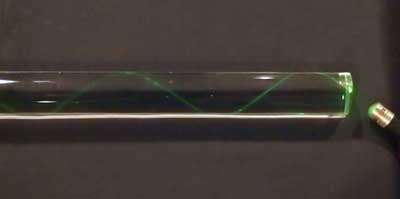
Cabling Project Management - what's involved in a copper/fiber/wireless project -advice for the customer and the contractor
Hazards Of Counterfeit Cable
You may have read the stories we have written about the counterfeit "Cat 5" cable made from copper-clad aluminum rather than pure copper. Recently we tried an unscientific burn test on the cable compared to a known good UL tested cable and posted a video on YouTube. You can see the results below.
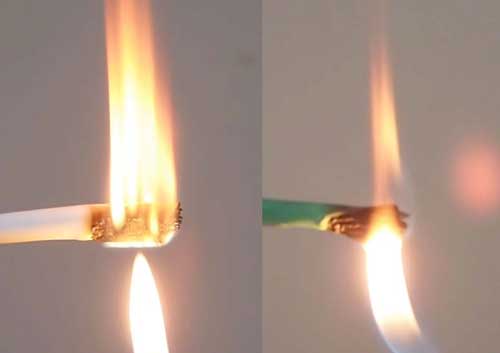
Counterfeit Cable Real UL-rated cable
The difference is obvious and the danger is real. Watch the video on YouTube: Premises Cabling Lecture 11: Counterfeit Cat 5 Cabling
View a complete list of FOA Videos with links to each video on YouTube.
View all the FOA Channel on YouTube.
RETURN TO INDEX

What's New in the FOA Online Fiber Optic Reference Guide?
We are continually updating the Online Reference Guide to keep up with changes in the industry and adding lots of new pages of technical information. Go to the FOA Guide Table of Contents to see the latest updates - look for  . .
Find What You Want Using "Google Custom Search
 There's so much information on the FOA Tech Topics and Online Fiber Optic Reference Guide that even a well-organized Table of Contents isn't enough and when the material is always changing, an index is impossible to maintain. So the FOA is using the latest technology in search, Google Custom Search, which will allow you to search just the FOA Tech Topics and Online Fiber Optic Reference Guide for any topic you want to find more about. Try it! There's so much information on the FOA Tech Topics and Online Fiber Optic Reference Guide that even a well-organized Table of Contents isn't enough and when the material is always changing, an index is impossible to maintain. So the FOA is using the latest technology in search, Google Custom Search, which will allow you to search just the FOA Tech Topics and Online Fiber Optic Reference Guide for any topic you want to find more about. Try it!
Go to The FOA Online Fiber Optic Reference Guide.
RETURN TO INDEX
New Schools
The FOA welcomes the newest additions to our listing of FOA-Approved Training Organizations:
The FOA network of training organizations offering CFOT (and more) certifications continues to expand. We welcome six new schools from quite different backgrounds - a manufacturer, an electrical JATC and several independent trainers.
Tellabs Training Services, Dallas TX school #363
Rally Training Services, Genola, UT, USA #364
Mundo Interconnect LLC, Mansfield, MA USA #365 (teaching in Ecuador)
Springfield Electrical JATC, Springfield MA school #653
Fiber Optic Training Toronto, Toronto, ON, Canada #366
Van Tek Consulting, Queen Creek, AZ, #367
Find a listing of all the FOA-Approved schools here.
Find An FOA-Approved Training Organization
Most inquiries we get regarding finding a FOA-Approved training organization want to know two things: what school is closest to me or what school offers the certifications I need. The FOA has about 200 training organizations we have approved worldwide so finding the right one can be difficult! We've been looking at ways to make it easier, and we think we've got a good solution. In fact we have two solutions.
First we have added a sortable table of all the FOA-Approved schools.
You can also use our FOA Google Map to find FOA-Approved schools.
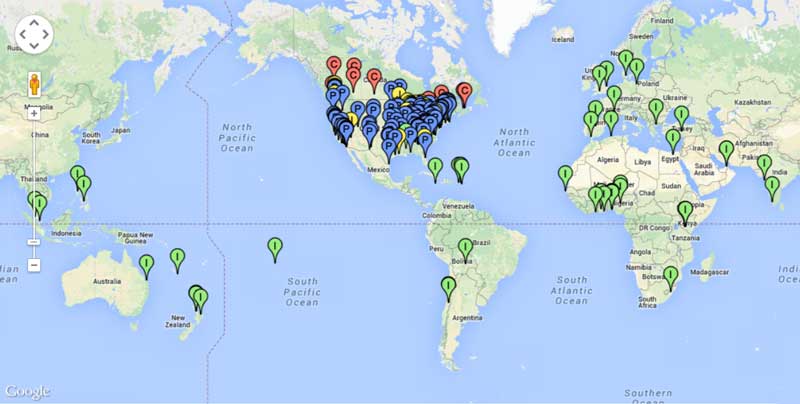
What Should A Fiber Optics or Cabling Tech Know and What Skills Do They Need?
FOA certifications are based on our KSAs - the Knowledge, Skills and Abilities that techs need to succeed. Read the FOA KSAs for fiber and cabling techs.
School News
Feedback
We always enjoy feedback, especially when it shows how great some FOA instructors are. These came from students of Tom Rauch, an instructor at BDI Datalynk:
"I took your fiber optics certification courses this past March. I just wanted to let you know that in two weeks I start working as a fiber optic technician with ___ up in ___. You mentioned on the first day of the course that there is always one guy in class who had rubbed his last two nickels together to be there and, in that instance, I was that guy. Now I'm going to be able to provide for my family like never before and I owe it to the certification that I received from you and BDI Datalynk. I just wanted to thank you again."
"Thanks to our tremendously knowledgeable and patient instructor Thomas Rauch, who was not only generous in sharing his wealth of information, but he did so with ease, humor and in a way that invited curiosity and participation. He was encouraging and proud of our accomplishments and helped us learn from our mistakes in a way that did not break our confidence, rather it pushed us to better results the next go around. The hands on labs were just AWESOME!" Just thought you should know what a class act you have representing you in his travels..... but then again you probably already knew that! : )
In almost 19 years at Verizon and having held numerous positions, I have gone through many training sessions. I cannot remember ever having been actually looking forward to coming back to class quickly after lunch, to get back to the hands on activities, and walking away with the sense of empowerment that the information presented was not only relevant but dead on point accurate! I will be signing up for the Outside Plant class on March! I can't say enough good things about Tom and his impact! Feel free to quote me, I can only imagine that he will open so many doors and change so many lives in the years to come, with his style of teaching! Great experience, awesome job!"
IBEW and FOA Partner on Fiber Optic Training
The International Brotherhood of Electrical Workers (IBEW) and the National Electrical Contractors Association(NECA) through the National Joint Apprenticeship and Training Committee (NJATC) in a partnership with the FOA has published a new textbook for training IBEW apprentices and journeymen in fiber optics. The new textbook uses the material from the FOA Reference Guide To Fiber Optics with new material and photos from other NJATC training partners.
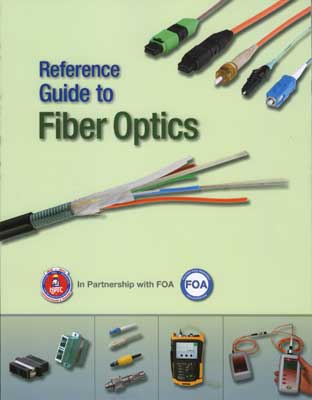
Quote from one of our certified instructors: I want to thank you and your organization for all the resources you provide for the students and the opportunity to offer the certification to the students. The fact that you published the book yourself to get the cost down and the unlimited free resources on your website shows a commitment to the public that is second to none. I let it be known to the students that the FOA is the best in the industry at supplying knowledge and resources related to the communication industry. I look forward to passing on the information that you provide for the industry.
RETURN TO INDEX
Good Question! Tech Questions/Comments Worth Repeating
Real Questions From FOA Newsletter Readers
Directional Testing
Q: I have taught for several institutions and throughout all my years of doing this I was always taught that when testing for insertion loss and back reflection for singlemode cable links that testing bi-directional is an imperative. Recently when I was attending a meeting involving members of the military along with folks involved in the development of the military manuals, it was mentioned that with singlemode testing that bi-directional testing is not necessary.
A; First of all, there is a directional difference in splice or connector loss - and maybe reflectance (that term is now almost universally used in place of “back reflectance” which is a poor term since a reflection is always back) - as long as two different fibers are being spliced. Fiber geometry is the main difference - mode field diameter in SM and core diameter in MM - but it can also be a matter of the fiber composition.This happens if two different manufacturers’ fibers are joined or bend-insensitive (BI) fiber with differences in depresssed cladding geometry are joined.
If you test bidirectionally with sufficient accuracy, you can see the difference. It’s an OTDR trace that most people are familiar with - if you see a gainer, you shoot the other direction and average to get the “actual” splice loss. When splicing or connecting different types or manufacturers SM fiber you may see directional differences of up to 0.3dB or more. Same for MM, not only for differences in core diameter but also for connecting BI to non-BI fibers. While those OTDR measurements are actually differences in backscatter levels, they are indicative of real differences in connector loss or splice loss in opposite directions.
Are those differences enough to be of concern? That’s a judgment call.
We’ve found most people do their bidirectional testing all wrong. With an OTDR, you should disconnect the instrument, not your launch and receive cables, and take just the instrument to the other end. Disconnecting the launch and receive cables changes the fibers at the connections to the cable under test and you lose the connection you want to test from the opposite direction.
Bidirectional testing with a test source and power meter is more confusing. You have to do your “0 dB” reference, check the launch and receive reference cables, measure the cable under test, then move just the source and meter to the other end, test the cable under test again, then disconnect and then measure the output of the source to get the “0 dB” reference used in that direction. That’s confusing!
Even if you do test bidirectionally, you do not get the “actual” connection or splice loss like everybody says - you get the average of the two directions. Unless you are willing to do a lab setup and some careful testing, that’s the best you can do.
Now we are into measurement uncertainty. If the measurement uncertainty is around the same as the typical bidirectional difference, does bidirectional testing gain you that much?
That’s a judgement call.
The new FOA book on testing goes into this - a complete chapter is devoted to measurement uncertainty.

When To Test Fiber
Q: Should testing of the fiber plant be done before the Optical Network Terminal is installed?
A: Fiber optic testing is generally done when the cable plant is installed to confirm proper installation and check that the performance is adquate for the electronics planned for use on it.
There are several processes - first an overview of testing:
Check cable before installing - continuity if it looks OK, OTDR testing if the reel is damages
Test installed cable when splicing - check the fusion splicer estimate of loss and do OTDR testing if questionable and inspect every connector as termination is done to confirm the connector is good.
Test cable plant after splicing and termination - end-to-end insertion loss and OTDR testing for longer OSP (outside plant) links.
New singlemode cable plants for high speeds may need "fiber characterization” - adding in CD (chromatic dispersion), PMD (polarization mode dispersion) and SA (spectral attenuation for DWDM wavelengths) testing. If one is considering upgrading a cable plant that is already installed or has been used, these same tests should be done - inspection/cleaning, insertion loss, OTDR.
When the system is installed, one should know it should work because of the testing done during installation. One should inspect and clean patchcords before installation and test them if suspect. In fact any connector needs inspection/cleaning before hooking up equipment. Dirt is the biggest problem with fiber optic systems.
Differences Between Singlemode or Multimode Mating Adapters
Q: What is the difference between singlemode and multimode bulkhead/adapters (mating adapters). My understanding is you cannot use the singlemode with the multimode and visa versa.
A: There are 3 types of adapters - rated for SM or MM - based on the alignment sleeve material.
-Plastic (glass filled thermoplastic) alignment sleeves are cheap, not very precise and wear quickly (you can see ceramic ferrules get dirty using them) - only good for multimode and one or two insertions - not recommended
-Metal (phosphor bronze) alignment sleeves are better with good alignment but still wear some - OK for MM, some are rated for singlemode (check before you buy), and are OK for most uses but will wear out if used for repetitive testing
-Ceramic alignment sleeves are the best and most expensive. They are very precise in alignment and last for a long time. Recommended for all singlemode and all testing purposes.
Don’t use MM adapters for SM but SM adapters are OK for MM.
Why A Figure 8?
Q: What is the reason for wrapping the cable in a figure eight?
A: When you need to do an intermediate pull, you have to pull the fiber and coil it on the ground. A simple coil will put a twist in the cable. Figure-8 coils put in twists of opposite directions on each side of the 8 making for no overall twist in the cable. See How To "Figure 8" Cable For Intermediate Pulls in the FOA Online Guide.
Can I Build A GPON Network With "Taps"?
Q: Can I build a GPON network where I do a drop to one subscriber then continue to the next subscriber for another drop and so on?
A: There have been examples of this type of “tap” drop proposed, for example in rural areas for drops to widespread subscribers on a longer network than is typical for FTTH. It’s just a version of a cascaded splitter network. with taps that just do a 2 way split. The taps used are typically 90/10 taps, where 10% of the power is tapped off for the drop.
There are some important issues to consider - Since you are dropping 10% of the power at each tap, you are limited by how many drops you can have. If you calculate the loss budget - after the first tap, you have 90% power left less the excess loss of the splitter (~0.3-0.5dB). The tap power is down ~10.3 dB and the through power is down ~0.6 dB. At the next tap, you use the same formula plus you add the loss of the fiber to that tap and so on until you reach the GPON limit. It’s a pretty complicated process to design, but you can see that with these power losses you will not get a large number of drops in a GPON network with 28dB max power budget. We did a rough calculation and 20-24 drops may be possible depending on the fiber lengths.
This network will probably be much more expensive and more distance limited than simply running a cable with many fibers and dropping fibers from that cable with midspan entry. Couplers are expensive, fiber is cheap. We also do not know the issues with the large differences in transmission times between the first connections and the last ones, which depends on the length of fiber in the systems. That may require some programming at the OLT.
Replacing OM1 MM Fiber
Q: We are an automation system integrator in South Africa. We have a client that has multimode 62.5/125 fibre optic plant wide. None of the runs between components are longer than 2km. We intend to upgrade the technology from a proprietary communication protocol to a standard ethernet protocol at 100 MHZ. The fibre to copper convertors we will be using are using 1300nm light source and have a Fibre Optic Link Budget of 12.8dB for 62.5/125 um and 9.8dB for 50/125 um. The client has been advised to replace the multimode 62.5/125 with multimode 50/125 cabling and we need to know if this is really a requirement.
A: Do you know how old the fiber is? It should be what we called FDDI grade 62.5/125 fiber with a loss of ~1dB/km and a bandwidth of 500MHz-km at 1300nm. A 2km link should have a loss of 2dB for the fiber and ~0.5dB/connection - well under the power budget of the link. 100Mb/s Ethernet variants were designed for 2km or more on this fiber. There is no reason to upgrade at this time, 50/125 fiber would not be needed until Gigabit Ethernet was desired.
Do We Need Repeaters For 30 Mile Link?
Q: I need to design a 30 mile (~50km) link. Will regeneration like a fiber amplifier be necessary?
A: It depends on the comms equipment but I doubt you need regeneration. 30 miles is 50km, only 10dB of loss for the fiber at 1550nm, maybe 10 splices at <0.1dB adds only 1dB loss and another dB for connectors on each end. I think you probably can find equipment that runs on 12dB loss budget. That said, most new high speed systems (>10G) have 20km versions then go to expensive long haul coherent systems. So talk to the communications equipment manufacturers and see what they say. If you do need a EDFA, they are not that expensive but the site is expensive and requires power (+ backup). See if it’s possible to put the EDFA in the end facilities to get enough power for the whole run.
Testing PCS Fiber
We Get Many Questions From Our Instructors Also
Q: I recently did a CFOT training class for a government agency. They use 200 micron core fiber in short sections (50 ft. the longest) within aircraft. The connectors are SMA 905s. The cable specs state that there is 8dB of loss in 1 km at 850nm. I have searched but cannot find any info regarding how to test the cable/connector links. The OLTS they have uses 62.5/125 jumpers. Is testing these cables with the above OLTS setup at 850 nm a valid testing method?
A: That’s 200/240 PCS or HCS fiber - plastic clad silica or hard clad silica step-index fiber - that has a glass core and plastic cladding. It has been used on a lot of platforms because it’s large core makes connection alignment easy. The SMAs are used because the connectors are air gap connections so vibration will not cause scuffing that you can get with PC - physical contact connectors. On aircraft, the 1/4-36 nuts on the SMAs are usually safety-wired too.
Testing can be done just like any other cable plant with a double-ended test (OFSTP-14) for the whole cable or a single-ended test (FOTP-171) to check the connection on either end. You need a 850nm LED source and a meter with a large detector (>2mm) to pick up all the light and an adapter for SMA connectors. You also need launch and receive cables of matching fiber and connectors about 2m long. No worries about mode conditioning since the step-index fiber is a mode mixer itself.
Fiber attenuation coefficient of 8 dB/km sounds about right. Connection losses ~0.5-1.0 dB are normal. A typical patchcord would have a loss of ~1-2 dB.
To get a microscope to view it might be difficult.
VFL for 10km?
Q: I have 10 kilometers of singlemode cable installed that was not labeled. It has been suggested that we shoot a VFL down the fiber and label it. I am having trouble finding a VFL that will shoot this far. Any ideas?
A: Occasionally we see some imported VFL that claims to go 10km or more. That tells us the company is clueless about fiber optics. VFLs work at ~650nm in the visible red spectrum while SM is optimized for 1300-1600nm in the infrared where it has a loss of ~0.3dB/km. At 10km it has a total loss of ~3dB or half the input signal. At 650nm, singlemode fiber has a loss of ~10dB/km which means it loses 90% of its power per km. At 10km, you have 100dB of loss - leaving you with 0.00000001% of the input power - not much!
VFLs have enough power for 2-3km max. To identify fibers at 10km, you need a 1310nm laser source and a power meter to do continuity. Or a gadget called a fiber identifier. For more info, see http://www.thefoa.org/tech/ref/testing/Instruments/instr.html and http://www.thefoa.org/tech/ref/basic/test.html
Connecting WiFi Access Points In a Passive Optical LAN
Q: If we install GPON passive fiber optical LAN in a new hotel, would one need to run fiber to every AP? Since every hotel room needs an AP this gets expensive. Any suggestion on the simplest and less expensive way of connecting Fiber Cable to an AP in the hotel room?
A: You do not need a fiber to every wireless AP in a GPON passive optical LAN (POL). The AP needs a UTP (Cat 5e/6) cable with Gigabit Ethernet and POE (Power over Ethernet) capability. The POL fiber should terminate in a multiport switch that has a fiber input and then 4 or more UTP/POE outputs for the wirelses APs. That’s the cost saving architecture of a GPON POL. See this page in the FOA Guide: http://www.thefoa.org/tech/ref/appln/OLAN-POL.html
You should also check out the APOLAN website (http://www.apolanglobal.org) for more information on hospitality applications with POLs.
Wireless Infrastructure
Q: I am wondering how the landscape will change as the nation moves from 4G-LTE to 5G. Will it use the same network as currently, or will the network need to be updated or replaced? To what extent will 5G be dependent on wireless vs fibre optic? Will the infrastructure nationally move more toward an underground wired one, rather than a Radio Access Network?
A: The wireless network is totally dependent on fiber optics for it’s communications backbone. The “wireless” part is the connection from an antenna to the mobile device. From that point, the network is cabled, mostly fiber already and soon to be all fiber.
4G/LTE and soon 5G in urban areas is moving to “small cells” with about 10X as many cell sites covering much smaller areas. Every small cell site needs a couple of fibers. Metro backbones will require very much larger fiber counts, especially with C-RAN (centralized radio access network) architectures now being implemented.
An example is Santa Monic, CA where we live. It has about 200K citizens, 8.9 square miles(about 23 sq km), but has planned for 600 small cell sites, spread over multiple service providers.
At FOA we see wireless as one of the most active areas for fiber, along with data centers.See http://www.thefoa.org/tech/ref/appln/wireless.html
OTDR Setup
Q: What are good OTDR settings for a 300-500m fibers? We’re using a 1.5 m launch cable and sometimes got (-) loss,
A 1.5m cable is not a launch cable. A launch cable must be long enough to allow the OTDR to settle down after the test pulse. THe negative loss is because the OTDR has not settled down sufficiently.
Generally the minimum launch cable for testing short cables would be 10-20m for MM, 100m for SM. Then use the shortest test pulse, ~1km range, average enough to reduce the noise.
Arsenic Coated Cable?
Q: I was told a contractor installed arsenic coated fiber optic cable because they didn’t want animals to chew through it. Is this true?
A: Some cable has chemicals put in the jacket to make it taste bad to rodents. We have not found any one who claims to use arsenic, in fact, we could find no references to what kinds of chemicals are used.
Why Do Cables "Go Bad"?
Q: It’s been my observation over ~15 years of building and managing fiber channel storage area networks that from time to time cables will fall out of transmission spec. In terms of communicating with non-storage people, they in essence, “go bad”. Other than possible damage due to physical disruption of a cable, or contamination at the connectors usually caused by a human being unplugging/replacing, has it been your observation that MM cables can “go bad”?
A: There are some possible causes of problems over time. We know of connectors that fail for several reasons.
- The biggest cause is with prepolished/splice connectors with mechanical splices. the assumed problem is the index matching get goes bad, but that’s highly unlikely. It’s usually the crimp fails and the fiber pulls out, especially if it has any stress on the fiber.
- Adhesive connectors can have a bond between the connector and fiber fail, more likely on anaerobic connectors.
- Any stress on the fiber at the connector is bad. Patchcords should not be left hanging on racks but dressed into horizontal racks below each patch panel.
- Residual stress in cables can be a problem - tension or tight bends - and they may get worse over time.
- Moisture is always a worry. It takes years to show up, but indoor cables are not protected from moisture like OSP cables.
- Of course, transceivers fail too - electronics are generally very reliable but do deteriorate over time and cause failures.
We always say fiber requires no maintenance - set it up right and lock it up. As you pointed out human intervention is often the issue.
Fiber Ports Or Media Converters?
Q: Should I Buy A Switch With Fiber Ports Or Use Media Converters?
A: I’m assuming you are thinking of using a switch with copper Ethernet ports and a media converter instead of a switch with fiber ports. The downside is that it adds complexity and increases the chance of failure. My analogy is something my primary flight instructor told me many years ago - multiengine planes are not safer because having two engines doubles your chance of having an engine failure. IBM still says that most network problems are cabling problems. Using media converters adds more electronics, more power supples and more cabling connections.
Testing PON Meters And Sources
Q: We're evaluating PON power meters and test sources. How should we test them? Do we need a PON network?
A: There is no requirement for having a PON to test the meters. I would check it against a meter you trust to test
1) if the reading of absolute power (dBm) agrees - should be within +/-0.2dBm. Compare at several power levels, as high as possible (~0dBm with a laser), medium, (~ -20dBm) and very low (~ -40dBm)
2) make some loss tests of cables and attenuators over the range of 1-5-10-15-20dB and compare to a meter you trust.
3)the extra calibration at 1490 is not an issue - the difference between 1490 and 1550 is very small and providing that calibration can be more a confusion factor since there are no transfer standards for that wavelength.
3) The big issue with sources is stability. Connect the source with a short cable to a trusted power meter, connect it to its power supply, turn it on and monitor the output over time. There should be a short warm-up period and then it should be stable within a few 0.01s dB. Let it run on batteries until the batteries run down to ensure that the source has a proper power supply that keeps the light output stable over time as the batteries discharge.
High Loss At 1383nm?
Q: We tested one link of 90.8 km at 1310/1383/1550nm and we got high loss at 1383 while other wave lengths have good results. What's up?
A: That wavelength is the center wavelength of the OH+ water peak, so you are seeing the extra attenuation there. Older fibers will have attenuation of 2-3 dB/km at that wavelength but new “low water peak” fibers will be <1dB/km. See “Low Water Peak Fibers” here http://www.thefoa.org/tech/ref/OSP/fiber.html
Polishing Films
Q: Are there different grades (micron) polishing films/papers for multimode and single mode fiber cables in ODF termination ? If yes, What are the grades polishing papers for multimode 50/125 um and 62.5/125 um fibers.
A: The polishing of MM and SM fiber is indeed different. Both start with an “air polish” with 12micron alumina polishing film to remove the protruding fiber. Then the polishing continues on a soft polishing pad (3mm 80 durometer rubber).
MM uses a 3micron alumina polishing film polished dry then a final 0.3micron alumina film polish. See http://www.thefoa.org/tech/ref/termination/ConnHints.html
SM is usually done with a wet polish using as special polishing slurry and diamond polishing film. The diamond film will polish both the ferrule and the fiber to get the best end finish. See http://www.thefoa.org/tech/ref/termination/sm.html
There are even more pages of information on the FOA Guide at http://www.thefoa.org/tech/ref/contents.html#Components
Armored Indoor Cable?
Q: Can I get an indoor armored 8 core fiber optic cable?
A: Most cable manufacturers make indoor armored cable using corrugated wrap armor to protect cables from crushing loads from other cables especially in under floor installations.
MPO Connector Loss
Q: Is there a current standard, for maximum allowable loss, for MPO fiber connectors? If so… what is the standard # from EIA/TIA? (Was it amended in 568B, since they were introduced?) Would it be similar to standard connectors @ 0.75dB Max allowable loss?
A: The MPO is covered under the TIA 568 standard. All fiber optic connectors are the same - 0.75dB.
There are discussions being held at TIA and ISO/IEC on using a different method of specification, statistical in nature, that says X% would be less than YdB in several stages from 0.1-0.2 to over 1dB, but it’s led to some headed discussions.
MPOs for MM are probably no less than 0.5dB and SM are near the 0.75dB mark. At least the SM ones are APC (usual 8 degrees, but still a flat polish).
I’ve recently learned that MPOs are polished for fiber protrusion to try to get fiber contact, but the evenness along the line of fibers is harder to control.
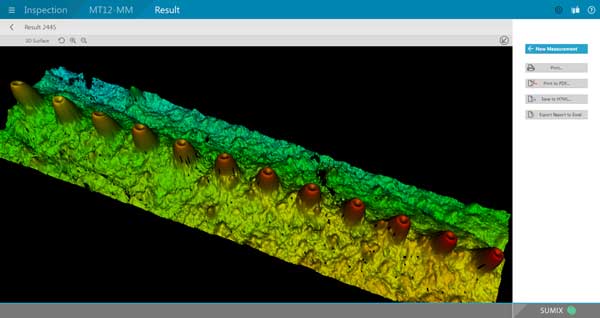
image from SUMIX showing protruding fibers in MPO connector
More Than “Single” Mode?
Q: We're now using SM fibre so it looks like we don't need mandrels in the Ref Lead at the Light Source. The info I have is that we need to make a couple of air coils 35mm to 50mm in diameter. Why?
A: When you launch from a pigtial laser source through a connector into a reference cable, you do have several modes being propogated. It usually takes 100m or so for the second or third order modes to attenuate. So the coil causes them to be attenuated by the stress enough to no longer be significant - it’s a mode filter just like MM. If you do not do this, you will measure higher loss in the fiber and at connections near the source. Since most SM has traditionally been long distance, the effect was small or ignorable, but with short links, it can be significant.
Followup Q: But how do we explain multiple modes in Single Mode fibre?
A: When you get the core of the fiber down to ~5-6 times the wavelength of the light, it no longer acts like geometric optics (like MM fiber). Some of the light can travel outside the core (see the note on “waveguide dispersion”here http://www.thefoa.org/tech/ref/testing/test/CD_PMD.html). At launch, significant amounts of power are at higher angles creating short lived modes that are highly attenuated.
Replacing OM1 MM Fiber
Q: We are an automation system integrator in South Africa. We have a client that has multimode 62.5/125 fibre optic plant wide. None of the runs between components are longer than 2km. We intend to upgrade the technology from a proprietary communication protocol to a standard ethernet protocol at 100 MHZ. The fibre to copper convertors we will be using are using 1300nm light source and have a Fibre Optic Link Budget of 12.8dB for 62.5/125 um and 9.8dB for 50/125 um. The client has been advised to replace the multimode 62.5/125 with multimode 50/125 cabling and we need to know if this is really a requirement.
A: Do you know how old the fiber is? It should be what we called FDDI grade 62.5/125 fiber with a loss of ~1dB/km and a bandwidth of 500MHz-km at 1300nm. A 2km link should have a loss of 2dB for the fiber and ~0.5dB/connection - well under the power budget of the link. 100Mb/s Ethernet variants were designed for 2km or more on this fiber. There is no reason to upgrade at this time, 50/125 fiber would not be needed until Gigabit Ethernet was desired.
Bi-Directional OTDR Testing
Q: Should the testing be done with the same piece of equipment from both ends then merge the results or does that not matter - can you use traces from two OTDRs as long as the test equipment is compatible and settings are adjusted properly.
A: Yes, you should use the same test set from each end but this way - take a trace, disconnect the OTDR from the launch cable and go to the far end of the receive cable and connect it there to take the second trace. The usual way people do bi-directional tests is to disconnect the launch cable and take it to the far end and shoot back up, often not using a receive cable at all, figuring they get the far end connector on the second test. But when you disconnect the launch cable (and/or the receive cable) you lose the connection you want to test in the other direction! As for using the same OTDR, every OTDR is different and the results you get may be significantly different, esp. if they are not calibrated recently - and few OTDRs are ever calibrated.
Passive OLANs in Hotels And Resorts
Q: Are passive OLANs a good choice for hotels or resorts?
A: Passive Optical LANs are enterprise networks based on fiber to the home (FTTH) technology not Ethernet over structured cabling. The FTTH network is usually using GPON standard equipment over one singlemode fiber with passive optical splitters that provides basic Level 1 and 2 network functionality. This is not Ethernet but carries Ethernet over the GPON protocols at 2.5G downstream and 1.25G upstream.
Passive OLANs offer several advantages over conventional Ethernet switches and structured cabling, including much less cost (~50% capital expense and ~20% operating expense), much lower space requirements (see the link to the library photos below and note the two racks of equipment that support 4000 drops), longer distance requirements (to 20km), easy expansion (these are systems designed for hundreds of thousands of users) and easy management (when you have hundreds of thousands of users, that’s important.)
For hotels, convention centers and similar facilities, the ease of upgrading to a passive OLAN is a big advantage - one fiber goes from the computer room to a splitter where it can serve 32 switches of 4 ports each. That’s right, one fiber can support 128 users! It can support anything that a network can - wireless access points, security cameras, secure entry systems, VoIP phones or POTS phones - anything that will run over a conventional network.
Calibrating An OLTS
Q: I have a question about the OLTS - do you have to recalibrate it every day ?
A: Any optical loss test set needs to be calibrated for “0dB” whenever anything changes - the launch cable - source output - or even every few tests to ensure the connector is clean and undamaged - plus they wear out. See 5 different Ways To Test Fiber Optic Cables.
Insertion Loss
Q: I have not been able to find a good definition of “optical insertion loss” or “insertion loss” or “optical loss.”
A: Insertion loss was the term originally used for the loss of a connector tested by a manufacturer. They would set up a source and length of fiber connected to a meter, measure power, insert a pair of connectors and measure the loss. Since it was an inserted connection, it became known as insertion loss.
Over time, the term insertion loss became more widely used to contrast with the loss measured by the OTDR, an indirect measurement using backscatter that may not agree with the loss with a light source and power meter.
Insertion loss, therefore migrated to meaning a loss measured of a cable or cable plant inserted between the launch and receive cables attached to a light source and power meter for double ended testing used with installed cable plants. For patch cord testing, you do not use a receive cable attached to the power meter but connect it directly to the cable under test, making the test just include the one connection to the launch cable.
Two other terms often mixed up are attenuation and loss, which are essentially the same, except when discussing a fiber. In fibers, attenuation is often used instead of attenuation coefficient. Attenuation is the absolute loss i dB while attenuation coefficient is the characteristic attenuation of a fiber expressed in dB/km.
Here is probably the best explanations: http://www.thefoa.org/tech/ref/basic/test.html
Old Fiber
Q: We are looking at a company’s fiber network which has been laid at various points in time over numerous years. In this process, we are trying to identify the changes that were made to either/both the glass fiber and the cladding. Are there different generations of what was industry standard in creating the fiber? For example, are you able to identify the difference in a fiber that was laid in 1980 versus one laid today? Was the cladding the same size/thickness etc. in 1980 as it is today or has this been modified/improved upon over the years? In all, we are trying to find what modifications have been over the years and how this may improve the life of the network and its capabilities.
A: This is a common problem today. Many network operators are evaluating their fiber networks for upgrades, hampered by the fact that few are properly documented. Below is a timeline that should answer your questions. What many network owners are doing now is testing their cable plants - a process called Fiber Characterization. There are contractors who do this service.
Fiber Tech Timeline
1976 - First field trials, US and UK, using multimode fiber at 850nm
1980 - First long distance networks still using multimode fiber at 850nm, planning to upgrade with wavelength-division multiplexing at 1310nm
1984 - singlemode fiber becomes feasible, telecom drops multimode fiber, all future installations are singlemode - this first SM fiber with a 9 micron core and 125 micron cladding is still available today but with better specifications. Really early fiber may not have good environmental protection and degrades over time. Early speeds were 145-405Mb/s, up to 810Mb/s by the end of the decade.
1990 - around this time, modern fiber begins - better performance and environmental protection. Fibers for wavelength-division multiplexing in the 1500nm range appear allowing multiple signals on a single fiber and fiber amplifiers allow long spans.
1995-2000 - massive build-out of fiber backbone leads to glut of fiber - WSJ ~2001 says 93% of all fiber is dark. Speeds grew from 1.2-10Gb/s over the 90s decade
2000-date - massive Internet growth and mobile device growth eats up glut of fiber and demands many times more. Dense wavelength-division multiplexing becomes the norm. Speeds began at 1.2/2.5Gb/s, upped to 10, 40 and are now at 100Gb/s.
So most fiber installed after 1990 has the possibility of being used at 10Gb/s, after 2000, it’s probably OK for 40Gb, and since 2010, you are probably OK for 100G and maybe more. To verify performance, you test each fiber for connector condition, loss, spectral attenuation, chromatic dispersion and polarization mode dispersion. There are test sets that will do Fiber Characterization in basically one step.
Fusion Splicing Live Fibers
Q: Is it safe to fusion splice a live fiber, or is there a chance that
the light from the arc will damage the detectors in the modules at the end (20km-rated SM for us).
A: I have never heard of this being a problem. The amount of light coupled into the fiber from the splicing would be very small compared to a properly coupled laser. When a cable is broken you might be splicing the fibers that are live without knowing which are live and not caring. On your newer splicers this is not a problem. On the older splicers with the LID system you would have to reduce the power to get a good splice which they would do by putting a bend in the Fiber.
Duplex Communications Over One Fiber
Q: Is true duplex over a single fiber possible, or is more like a shared time-domain technique in a quasi-duplex mode? I would guess that true duplex would lead to interference problems.
A. Bidirectional links are widely used - that’s how FTTH PONs work. They use splitters to combine/split the signals and one wavelength downstream and another upstream. See Fiber Optic Datalinks and for FTTH FTTH Architectures.
Using Hybrid 2.5-1.25mm Connector Mating Adapters
Q. Can I use the hybrid 2.5-1.25mm adapters for connecting SC connectors to LCs or MU connectors. It would make testing much more convenient.
A: We do not recommend them for most uses, especially testing, as they can be highly unreliable. Reserve them for emergencies and use hybrid patch cords instead.
Test MM Fiber @ 1300nm?
Q: What is your opinion about the need for testing at 1300 nm on OM3 and OM4 fiber especially now that bend insensitive multimode fiber is taking over?
A: It’s unnecessary and costly. It’s rooted in the FDDI/100M days 25 years ago when 1300 LEDs were used and is now obsolete. The only actual uses at 1300nm I know are the extremely rare systems using 1310 lasers which may be standards but simply don’t seem to ever be used. As you say, BI fiber makes the issue of finding stresses moot.
Fiber In Service Loops
Q: We designing a rural utility system that will be expanded to FTTH (or FTTR - fiber to the ranch in this case). We're wondering how much excess fiber in service loops to add. One software package is asking for 12% but that seems excess.
A: I have typically seen 100 feet on straight through boxes (reserves), 35-50 feet on cut ends for splicing and anywhere from 15-25 feet at the premise depending on how much is required for the termination device, positioning, etc. When rough estimating we have typically used 10% over linear distance.
Maintenance of Fiber Networks
Q: Can you guide me how to prepare Optical Fiber Cable Annual Maintenance Proposal?
A: Basically, the network needs to be installed properly, fully tested and everything carefully documented. Then no routine maintenance is required. Most problems with fiber optic networks occurs when techs are working with it, e.g. damaging cables or getting connectors dirty when testing, so leaving it alone is the best plan.
Electronic transmission equipment can be tested anytime to ensure proper data transmission, but that does not involve accessing the fiber.
We have several things which may be of help:
You Tube Video: FOA Lecture 39 Maintaining Fiber Optic Networks
Web page: Maintenance
I have 4 questions about OTDRs:
Q: What is dynamic range I read many time but can’t understand yet, whether it is a range of losses can be measured by OTDR for example if an OTDR has 45 dB dynamic range, it can read the losses of point up to 45 dB or what it means.
A: I do not believe there is a standard definition of dynamic range, but it is generally accepted to be the highest loss of the longest cable where you can see the end of the cable. That usually means using the longest test pulse and most averaging and assuming the end of the cable has a significant reflection.
Q: What is dead zone is it fixed in meters mean an OTDR cannot measure up to initial 5, 10 or 20 meter
A: The dead zone is a function of the pulse width and speed of the OTDR amplifier. For most OTDRs it’s about 2-3 times the test pulse width.
Q: What Type of settings needed before launching a test
A: See FOA Lecture 18: OTDR Setup or the section "Modifying OTDR Setup Parameters For Best Test Results” in OTDR testing. A: Basically you set up wavelength(s), test pulse width (long enough to reach end of cable but short enough for best resolution), index of refraction or group velocity (a function of the fiber type and wavelength) and the number of averages (enough to mitigate noise but not take too long)
Q: Reading a test with 1310nm and 1550nm - why values different for a same length of fiber.
A: The attenuation of the fiber will be different at each wavelength and the index of refraction which is different at each wavelength causes a difference in length. The OTDR measures length by measuring time and then multiplying that by the speed of light in the fiber (which is the inverse of the index of refraction.)
The FOA page "Frequently Asked Questions About OTDRs" answers these questions and more.
Getting Old Cables Out Of Conduit
Q: How do you get old cables out of a conduit when they are stuck?
A: Usually we are concerned about reducing friction when pulling cables through conduit, but sometimes you need to get them out. Here is a page from American Polywater the leading lubricant company with advice on the subject.
Manufacturing Guide?
Q: Is there a guide published by FOA that provides insight as to the process of fiber optic manufacturing? It's my understanding that the guide stresses quality and controls to ensure performance and reduce product loss?
A: We do have a guide for manufacturers. It is mostly aimed at communications systems and components manufacture. Here is a link to download it.
How Long Does Termination Take?
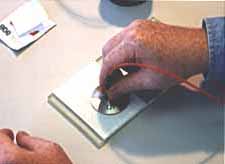
FOA received a request from a consultant recently wondering if we had information on the termination times for fiber optic cables. After some looking in our archives, we realized we had a document online that compared times for various fiber optic termination processes. The paper was written after several FOA instructors did a comprehensive time and motion study on termination processes. The document is about 15 years old but still relevant.
You can read it here in the FOA Online Guide.
Testing Connectors (From A Patchcord Maker)
Q: What are the chief defining standard(s) that specifies connector and assembly IL (insertion loss) and RL (return loss or reflectance) for both SM and MM fiber?
A: The description on our Guide is here: http://www.thefoa.org/tech/ref/testing/test/conntest.html
FOTP-34 covers connector testing as a qualification test for the type of connector - basically a "destructive" test for connector manufacturers.
Reflectance is described on that page and here also: http://www.thefoa.org/tech/ref/testing/test/reflectance.html
Testing an assembly like a patchcord is covered under FOTP-107 http://www.thefoa.org/tech/ref/testing/test/FOTP-171.html
Basic Tests For Fiber Optic Cable Plants
Q: I did some research and I noticed that there is a bunch of tests that can be done to fiber optics and I was wondering if there is a list of primary tests that can be done as a basic test.
A: Fiber optic testing does have a hierarchy of tests.
- At the top of the list is "insertion loss" testing which uses a light source and power meter to test the fibers in the same way that a communications system transmits over the fiber. It is a simple test and the equipment needed is inexpensive.
- Techs will also use a microscope to inspect the fiber optic connectors for dirt and damage, a big issue for fiber.
- The instrument called an "OTDR" takes a snapshot of the fiber using a technique like radar. Most outside plant cables are tested with an OTDR and the data ( the snapshots are called "traces") stored for future reference. OTDRs are more expensive and require more training to use properly.
Here is a link to a page on the FOA Guide site that explains the technical,details: http://thefoa.org/tech/ref/testing/test/OFSTP-14.html
FOA also has information just for users of fiber optic networks, see http://thefoa.org/tech/guides/UG3.pdf
How to Clean POF (plastic optical fiber)
Q: I heard that plastic fibres such as PMMA can suffer damage from cleaning from an alcohol solution. Are there alternate cleaning solutions available for these types of fibres."
A: You can use a 10/90 mix of isopropyl alcohol/water. Typically use with a lint free swab. (from out POF consultants)
Testing Bare Fibers With OTDR
Q: We are starting to test some OPGW cables. We have an OTDR but we don’t find some reusable connectors. If we have to test an OPGW with 48 fibres, we can’t set up 48 SC connectors!
Are there some reusable connectors in the commerce?
A: I assume you mean you need to test with a bare fiber on the OPGW. For testing bare fiber, use a splice, not a connector. Have a long pigtail on the OTDR as a launch cable, long enough for the test pulse to settle, say 100-500m, then use a splice for a temporary connection. You can fusion splice the fibers then cut the splice out or use a removable splice like the Corning Camsplice (http://catalog.corning.com/opcomm/en-US/catalog/ProductDetails.aspx?cid=&pid=17929&vid=18219)
If you use a mechanical splice, you need a high quality cleaver just like with fusion splicing and after several uses, you need to add more index matching gel or liquid - mineral oil works OK. See the FOA page on Testing Bare Fiber.
Is A Flashlight Test Adequate?
Q: I contracted a firm to install an OM3 of 200 meters. On one end I have an SFP 1000SX ,on the other a 1000SX converter from optical to UTP. We made pings but they never reached, and I didn’t see the laser at the extreme of the fiber. They promised me to send me the certification they supposely made ,though they assured me the fiber is ok, because WITH A FLASHLIGHT THEY SENT WHITE LIGHT FROM ONE SIDE TO THE OTHER AND IT WAS VISIBLE. I saw the light too, and I thought the culprit was my switch or my SFP. I want to know: is this a good demonstration that the fiber is ok?
A: A visual continuity test is not adequate - your eye is not calibrated! The power of the lamp is unimportant as each eye’s sensitivity is different. And your eye probably cannot see the light from a 850nm VCSEL source - most people’s eyes are not sensitive at that infrared wavelength. The installer should have tested the link with a light source and power meter (http://www.thefoa.org/tech/ref/testing/test/OFSTP-14.html) and given you the loss in dB. The connectors should also be inspected with a microscope to ensure proper polishing and cleanliness (http://www.thefoa.org/tech/ref/testing/test/scope.html). If the SFP output is -6dBm, what is the power at the receiver? 1000base-SX is supposed to work with 4.5dB loss (see http://www.thefoa.org/tech/Linkspec.htm). The fiber loss should be ~0.6 dB, so you must have >4dB connector losses! That says bad installation! The 1000SX link should work over 200m if the fiber has been properly installed.
Older Fiber?
Q: I have some 62.5 mm and sm inside fiber plant over 20 years old. When is a good time to upgrade?
A: When you need to or have to. If it's working OK, there is no need to upgrade!
"Connector Loss" or "Connection Loss"
Q: I have always counted the loss of a connector as .75 dB (568B-3) and 1.5 for a mated pair. Is that correct?
A: While the industry always says "connector" loss, it is actually "connection" loss. As we explain in the page on termination and splicing (http://www.thefoa.org/tech/ref/basic/term.html) When we say "connector" loss, we really mean "connection" loss - the loss of a mated pair of connectors, expressed in "dB." Thus, testing connectors requires mating them to reference connectors which must be high quality connectors themselves to not adversely affect the measured loss when mated to an unknown connector. This is an important point often not fully explained. In order to measure the loss of the connectors you must mate them to a similar, known good, connector. When a connector being tested is mated to several different connectors, it may have different losses, because those losses are dependent on the reference connector it is mated to."
The TIA spec of 0.75dB is for a mated pair of connectors. If you have been passing connectors tested @ 1.5dB loss....you may have some very bad connectors in your cabling!
Microscope Magnification (11/13)
Q: I am doing a lot of fiber optic jumpers for control systems, either single mode or multimode. I want to get a scope to inspect the ends after I clean them would you recommend a 200X, 400X handheld or one similar to a Noyes OFS 300 200C?
A: We prefer to use lower magnification and have a wider view so I can see more of the ferrule to determine its condition. You can see the fiber effectively at 100X but 200X may be better. 400X may be too much for most tasks like inspecting for cleanliness, but may be good if you are polishing SM for good reflectance. We've used the Westover units for years because they offer two different methods of illumination - direct and at an angle. If you are doing a lot of patchcords, I recommend a video microscope. I've used the Noyes unit that interfaces to a PC to create the FOA Microscope Inspection YouTube video here: http://www.youtube.com/watch?v=IyumH8CiUPQ&feature=youtu.be and it works well.
Recycling Cabling
Q: Who can I contact regarding recycling cable I am removing from a building?
A: Here are some people who say they recycle fiber optic cable or at least know how to do it:
http://www.scottrecycling.com/complete.html
http://www.scrapmonster.com/selloffer/fiber-optic-cable/10400
http://www.dnvkema.com/services/ces/hse/recycling/recycling-cables.aspx
http://tmscrapmetals.com/Recycling.html
Tech Hint: Did You Know You Have A Fiber Optic Tester In Your Pocket?
Yes! That old mobile phone has a camera which may be sensitive to infrared light - lots more than your eye - and can detect light in an optical fiber or from a transmitter. Chris Hillyer,CFOT/CFOS/I, Master Instructor, Northern California Sound & Communication JATC sent us some photos showing how this works. See below or the video now on YouTube. Update: You should check out your old cell phones before you recycle them. We've found older models use sensors which are better at infrared than the newer ones which take better pictures. This is a good use for your old cell phones hiding in the drawer!
Fiber Cleaning
This is a topic we keep reminding everybody about, and here is why:
From a contrator in the Middle East: Here some samples of the connectors for SM fiber already installed in the system we were testing.
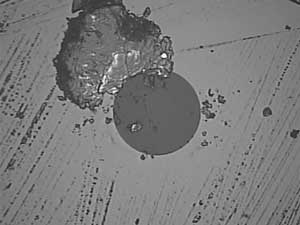 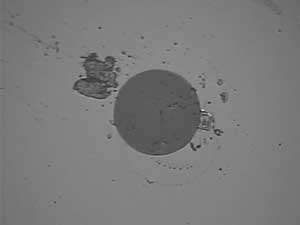
As you can see, the dirt is large compared to the size of the fiber (dark gray), and the core (not visible here) is only 9/125 of the overall diameter of the fiber!
Clean Every Connector - A Lesson We Learned From Creating Lessons
In creating the fiber characterization curriculum, we got inputs from many experienced techs about the testing requirements. Everyone we talked to made a big point about cleaning and inspecting connectors before testing. Dirty connectors are a major problem with errors in testing. We've also seen that many installers think that if a connector, especially new connectors, has a "dust cap" on the connector, it does not need cleaning. WRONG!
The common name for the plastic caps on connector ferrules is "dust cap" and a friend says they are called "dust caps" because they are full of dust. Those plastic caps are made by the millions, popped out of plastic molding machines into barrels and stored until put into plastic bags. Whenever you remove one of them, clean the connector before testing or connecting it.
More on connector cleaning is here and here.
More on cleaning. See Product News below for links to vendors of fiber cleaning products.
What You Need To Know About Fiber Optic Cleaning And More
Ed Forrest, one of the industry experts on cleaning fiber optic connectors, retired about a year ago. We encouraged him to put down on paper what he knew about fiber cleaning and he took our advice. He's now created 4 books on cleaning topics that cover just about everything you need to know. And he added another volume that's also important - maintaining fusion splicers. We recommend these books highly.
How to Precision Clean All Fiber Optic Connections
Understanding Cross-Contamination Points on Fiber Optic Inspection & Test Equipment
Maintaining a Fiber Optic Fusion Splicer
Comparison Study of Precision Cleaning Methods for All Fiber Optic Connection
Whitepaper: The Significance to Optical Internconnect: Properly Cleaning a Fiber Optic Connection
Information on Ed's books is at http://fiberopticprecisioncleaning.com/available-books-whitepapers/.
See news about Fiber Optic Cleaning Videos on YouTube by ITW Chemtronics below.
Fiber Optic Cleaning Videos on YouTube
See news about Fiber Optic Cleaning Videos on YouTube by ITW Chemtronics three fiber optic cleaning videos on YouTUbe covering Dry Cleaning, Wet-Dry Method, FiberWash and Combination Cleaning. They are good explanations of cleaning processes - the Wet-Dry is especially interesting.
Measurement Uncertainty: Everyone testing fiber optics should understand that every measurement has some uncertainty - whether you are measuring loss, length, wavelength, power, etc. Knowing that uncertainty is very important to interpreting the measurement. It's worthwhile to read and understand the issue of measurement accuracy covered in this page of the FOA Online Fiber Optic Reference Guide.
RETURN TO INDEX
Worth Reading or Watching:
Sign up at the FOA Pinterest board 
FOA "Quickstart Guides"
In our continuing quest to help people understand how to test fiber optic cable plants and communications systems, we've created two more "QuickStart Guides to Fiber Optic Testing." They are simple, step-by-step guides on how to test fiber optic cable plants, patchcords or single cables using insertion loss or OTDR techniques and optical power from transceivers. It's as straightforward as it can get - what equipment do you need, what are the procedures for testing, options in implementing the test, measurement errors and documenting the results.
It can't get much simpler.
Send anybody you know who needs to know about fiber optic testing here to learn how it's done in a few minutes.
Testing Fiber Optic Cable Plants And Patchcords
Testing Fiber Optic Cable Plants With An OTDR
Measuring Optical Power In Communications Systems
Like Crossword Puzzles? Here's Some On Fiber Optics

Do you like crossword puzzles? How about one on fiber optics - or maybe a half-dozen of them? FOA Master Instructor Eric Pearson of Pearson Technologies has created a series of crossword puzzles on fiber optics that are keyed to the FOA CFOT reference materials and his book Professional Fiber Optic Installation, v.9. You can have fun and study fiber optics at the same time!
This months crossword puzzle is on "Optoelectronics and Splicing" - Download the crossword puzzle on "Optoelectronics and Splicing."
If you missed the earlier puzzles, here they are:
Download the PDF file of the crossword on "Light and Fiber".
Download the PDF file of the crossword puzzle on "Cables".
Download the crossword on "Connectors & Splices."
Older Fiber, Do You Know How Good It Is?
There's millions of miles of long distance fiber installed around the world and most of it likely to see an upgrade of the systems operating on it, probably in the near future. Twenty years ago, most of it was probably running at ~1Gb/s, ten years ago it was probably 2.5 Gb/s, recently it was likely to be 10Gb/s but now many are being considered for 100Gb/s or beyond. Can the fiber support such speeds? Can it be "repaired" or "modified" to make it possible to use it at higher speeds? If you own that fiber, can you say what it is worth without knowing its future upgrade capability.
In order to know the potential for upgrades on your cable plant, you need to test it. This process involves a number of tests and is called "fiber characterization." Greg Stearns of TTP-US, an FOA Corporate Member, performs these tests and has written a short article on why you need to characterize fiber and how its done. Read about fiber characterization from someone who does it often and can explain it well.
Download the paper here (PDF, 80kB).
Demystifying Singlemode Fiber Types
Singlemode fiber has a lot of names and users are confused by the different names depending on the standards organization you refer to IEC, ITU or TIA designation. Most widely used are the ITU G65X designations but even there we find many designations. Shaun Trezise of M2FX has posted a simple explanation on the company blog that helps explain the different types and where they are used. Read more on the M2FX blog
There is a cross reference to the IEC, ITU and TIA designations on the FOA Guide.
EXFO Offers Super Posters And More

EXFO offers some super posters, guides and books. The FTTx and OTDR posters are really useful! Look at the whole selection here.
Getting Cables Out Of Conduit
Usually we are concerned about reducing friction when pulling cables through conduit, but sometimes you need to get them out. Here is a page from American Polywater the leading lubricant company with advice on the subject.
What Is The FOA?
Hear FOA President Jim Hayes tell the FOA Story in a 2-part interview by Sound & Video Contractor Contributing Editor Bennett Liles. It tells about the FOA history, goals and achievements.
Part 1: http://svconline.com/podcasts/audio/fiber_optic_association_part1/index.html.
Part 2 http://svconline.com/podcasts/audio/inside-fiber-optic-association2-0924/index.html.
What Happens To Old Fibers?
In a recent web search, we found this article from Corning, reprinted from a IWCS presentation in 1995. It discusses extensive tests on a 1984 cable installed in the northern US to see how it had degraded in almost 10 years. It is interesting to see how the fiber survived OSP exposure. Read it here.
Australia's Standard Is Comprehensive Guide To Customer Cabling (Get your copy free)
In answering a recent technical questino, Trevor Conquest in Australia pointed to the Australian Standard "Installation Requirements For Customer Cabling." When we checked, it is on the web and can be downloaded. It's a big book - 220 pages - full of details for fiber and copper installations. We recommend you download yourself a copy - go here.
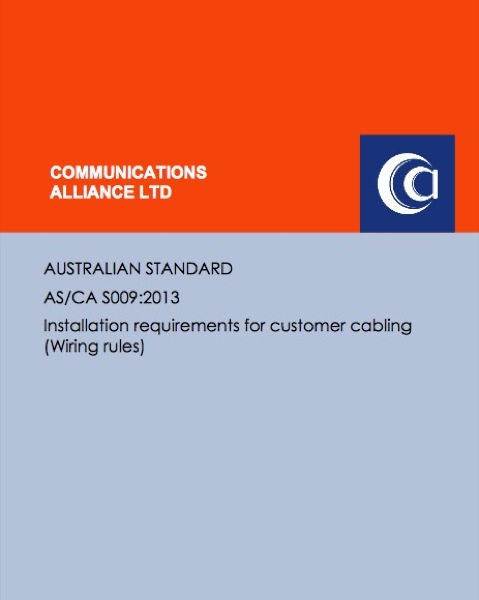
Demystify fiber inspection probe technical specifications - From EXFO
The intent of this application note is to promote a better understanding of video inspection probe specifications and features. Properly understanding the key specifications and features will greatly facilitate the decision process involved in acquiring such devices. Understanding the key aspects of fiber inspection probes will also help users understand how fiber inspection probes operate, thus enabling them to maximize the full potential of these devices. Read more.
Where In The US Do Contractors Need Licenses For Fiber Optics?
We often get asked where in the US do contractors doing fiber optic installations need licenses. We found a good website for that information, the NECA -NEIS website. You might remember NECA-EIS, as they are the partner with the FOA in the NECA/FOA 301 Fiber Optic Installation Standard. NECA is the National Electrical Contractors Association and NEIS stands for National Electrical Installation Standards. They have a very easy to use map and table that gives you data on every state in the US, so mark these pages for future reference.
NECA/NEIS
http://www.neca-neis.org (See “State Regulations”)
http://www.neca-neis.org/state/index.cfm?fa=state_regs (all electrical licensing)
Low Voltage: http://www.neca-neis.org/state/index.cfm?fa=specialty_licensing
How Is Fiber Manufactured?
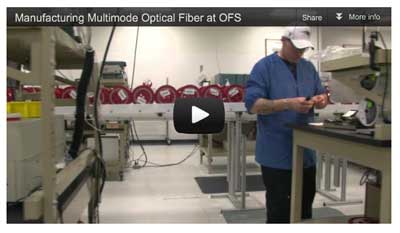
OFS invites you on a tour of their multimode fiber manufacturing facilities in this new 5-minute video. You will see their highly automated manufacturing operation in Sturbridge, Mass., including their patented MCVD preform fabrication process to fiber draw and final product testing. With a technological heritage dating back to AT&T and Bell Labs, OFS has been manufacturing high-quality multimode fiber since 1981.
Watch the video here.
Benchmarking Fusion Splicing And Selecting Singlemode Fiber
We've been asked many times "How long does it take to splice a cable?" It's not a simple answer as it varies with the number of fibers in the cable and the work setup, including whether one or two techs are working at a job site. FOA Master Instructor Joe Botha of Triple Play in South Africa did his own analysis based on decades of experience both splicing cables and teaching others how to do it properly. This is one of the best analyses we have seen because Joe includes prep times as well as splicing times and differentiates between one tech and two techs working together. He adds some other tips on fusion splicing too. This should be mandatory reading for every tech and given to every student! Here is Joe's splicing analysis.
Joe also has an excellent writeup on how to choose singlemode fiber that helps understanding the different types of G.6xx fiber. Read it here.
And you will want to read Joe's report on splicing different types of SM fiber, including bend-insensitive (G.657) fiber. Read it here.
Free - Mike Holt's Explanation Of The US National Electrical Code (NEC) For Communications Cables
Mike Holt is the acknowledged expert of the US National Electrical Code (NEC). His books and seminars are highly praised for their ability to make a very complicated standard (that is in fact Code - law - in most areas of the US) easily understood. Part of the appeal is Mike's great drawings that make understanding so much easier. Mike makes Chapter 8 of his book available free. It covers communications cables, telephones, LANs, CATV and CCTV, for premises applications. Even if you live in a region or country where the NEC is not the law, you may find this interesting.
Download Mike's Chapter Here.
Fiber Optic Cleaning Videos on YouTube
ITW Chemtronics has three fiber optic cleaning videos on  covering Dry Cleaning, Wet-Dry Method, FiberWash and Combination Cleaning. They are good explanations of cleaning processes - the Wet-Dry is especially interesting. covering Dry Cleaning, Wet-Dry Method, FiberWash and Combination Cleaning. They are good explanations of cleaning processes - the Wet-Dry is especially interesting.
-
- Download yourself a copy and read it!
-
Good Technical Website For Installers
American Polywater (http://www.polywater.com/) has one of the best technical website for cable installers. Check out their website, especially “Videos,” “Engineer’s Corner” and “Calculators.” http://www.polywater.com/NNNBSL.pdf
Fiber Optic Safety Poster
We've had numerous requests to reprint our guidelines on safety when working with fiber optics, so we have created a "Safety Poster" for you to print and post in your classroom, worksite, etc. We suggest giving a copy to every student and installer.
RETURN TO INDEX
-
FOA Tech Topics -
A Fiber Optic Tester In Your Pocket? (See the video on  ) )
Yes! The camera in your old cell phone is sensitive to infrared light - lots more than your eye - and can detect light in an optical fiber or from a transmitter. Chris Hillyer,CFOT/CFOS/I, Master Instructor, Northern California Sound & Communication JATC brought this to our attention.
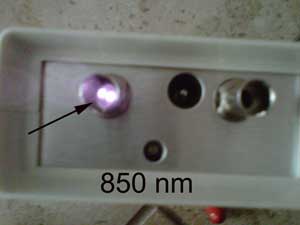 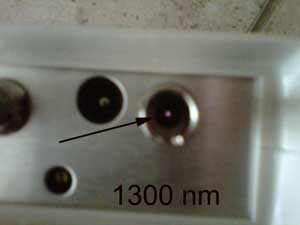
If you have an old cell phone, try it. Our experience is that older cell phone cameras have better sensitivity at IR wavelengths than newer phones, so you may want to toss that old flip phone into the toolbox.
RETURN TO INDEX
Product News
New Ripley Fiber Stripper
Ripley recently sent us some new fiber strippers to try, the Ripley Tri-hole fiber stripper model CFS-3. It is aimed at contractors and installers and is very reasonable prived - plus we understand there are some introductory price specials from some distributors.
The CFS-3 can strip fiber jackets, 900 micron buffer and 250 micron buffer for one step cable preparation.
- 1st hole strips 1.6 – 3mm Fiber Jacket to the 600-900 buffer coating.
- 2nd hole strips the 600-900 micron buffer coating to the 250 micron coating.
- 3rd hole strips the 250 micron buffer coating to the 125 micron glass fiber.
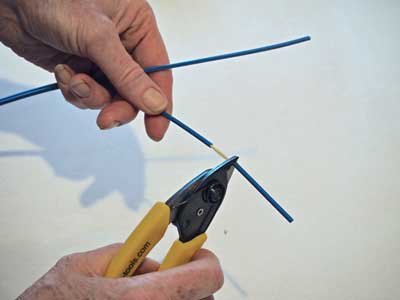
We tested the CFS-3 on several fibers and cables and found it easy to use and very consistent. It seemed much less sensitive to the angle you hold it at when stripping fibers than some strippers like this and it was very effective even stripping some older, more brittle fibers.
Here's more information on the Ripley CFS-3 Part #: 81300.
VIAVI Introduces OLTS For MPO Connectors
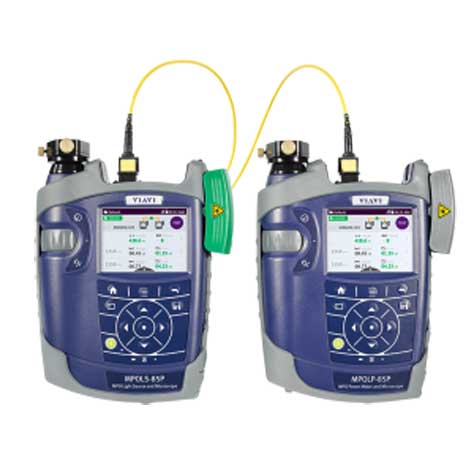
One of the biggest problems with multifiber MPO connectors is testing. Viavi Solutions (formerly JDSU) has introduced its SmartClass Fiber MPOLx optical loss test set, a basic test solution for cabling systems that utilize multi-fiber MPO connectors. The testing of parallel optics with MPO connectors has always been difficult for regular single or dual fiber OLTS, needing MPO to SC or LC breakout cables for testing one fiber at a time and using the three cable “0 dB” reference method. The MPOLx should make testing cable plants using these connectors much easier.
The MPOLx can test for length, optical loss, polarity and inspect fiber end-face condition - a complete cable plant test. The ability to check polarity is important since there are several polarity schemes used in MPO systems. The MPOLx is fast too, delivering comprehensive test results in less than 6 seconds for all 12 fibers.
More information on the Viavi MPOLx here.
YOKOGAWA OTDR Has Extended range, High Resolution And Multitasking
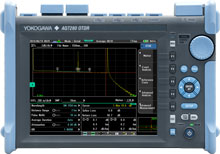
One OTDR manufacturer you don't hear as much about is YOKOGAWA (formerly ANDO) which is too bad - they make some of the best OTDRs, exemplified by this new model AQ7280. Need long range - how about 50dB. High resolution - 0.6m dead zone. Like touch screens, but for some functions want hard buttons, it's got that. Options for VFL, microscope, light source and power meter, etc. - it has that too.
But the unique aspect of the YOKOGAWA AQ7280 is it offers multitasking - you can let do a trace with long averages while you inspect connectors, make power readings, use the VFL or other functions.
More info on the YOKOGAWA AQ7280.
FOA thanks Yokogawa for a gift of an OTDR to use for R&D and teaching!
Recycling Communications Cable
FOA was contacted by a company that recycles electronics communications equipment and cabling. CommuniCom recycles cable/metals/e-waste for Telcos and CATVs. They also recycle Fiber Optic Cable and associated Materials (the fiber scrap). And, they reclaim OSP abandoned copper cables (abandoned from road moves or FTTx growth). This is a huge part of our business. They do the work (permitting/locates/labor) for free and we revenue share back with our clients (telcos).
Contact Steve Maginnis
smaginnis@communicominc.com
www.communicominc.com
803.371.5436 (cell)

Micro-Trenching, Cable Removal
Nano-Trench offers products for micro (or I guess they call it nano-) trenching and their website is very informative. They also have Kabel-X, a method of extracting copper cables from old conduit. Both websites are informative and interesting. Watch this video on the cable removal process!
Protecting Pedestals From Rodents
Pedestals and underground vaults can be damaged by rodents who come up through the base and damage cables. Uraseal "Drain N'Seal" foam deters mice from taking up residence in your pedestals. They have some good videos on using their product.
Used Test Equipment – Buy or Sell
http://www.testequipmentconnection.com/
Have you read the FOA pages on cleaning?
- RETURN TO INDEX
FTTH Notes:
- Want To Learn More About FTTx? Try our free online self-study program at Fiber U.
|


